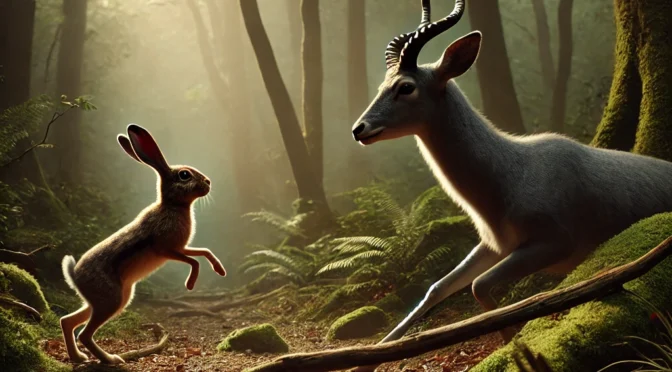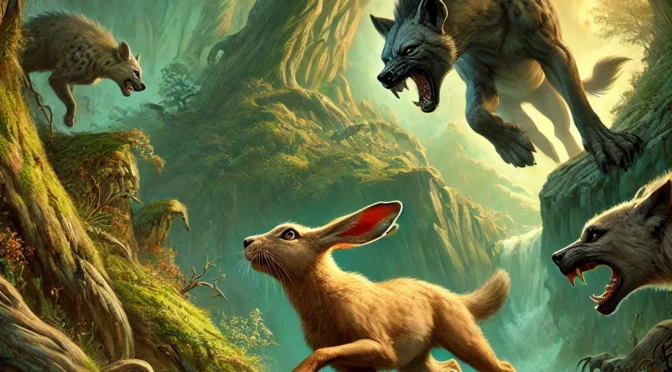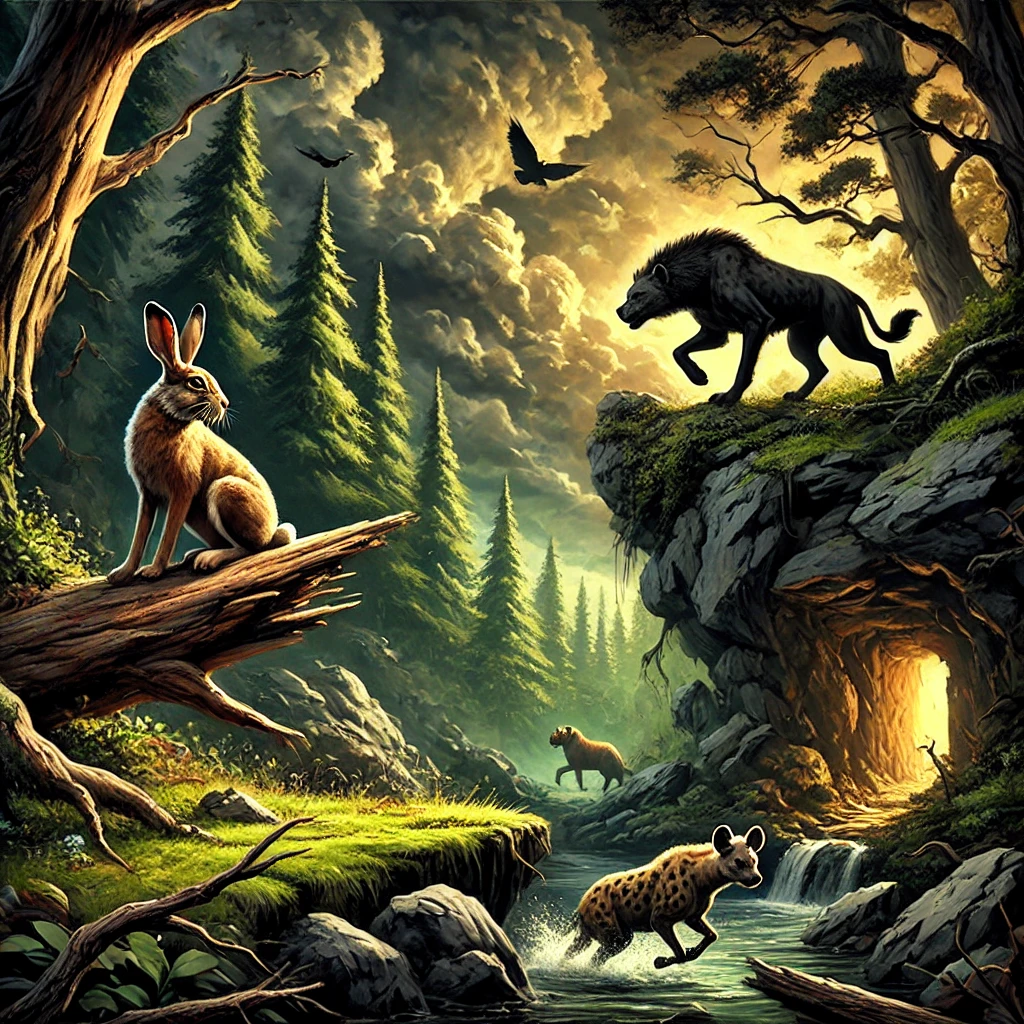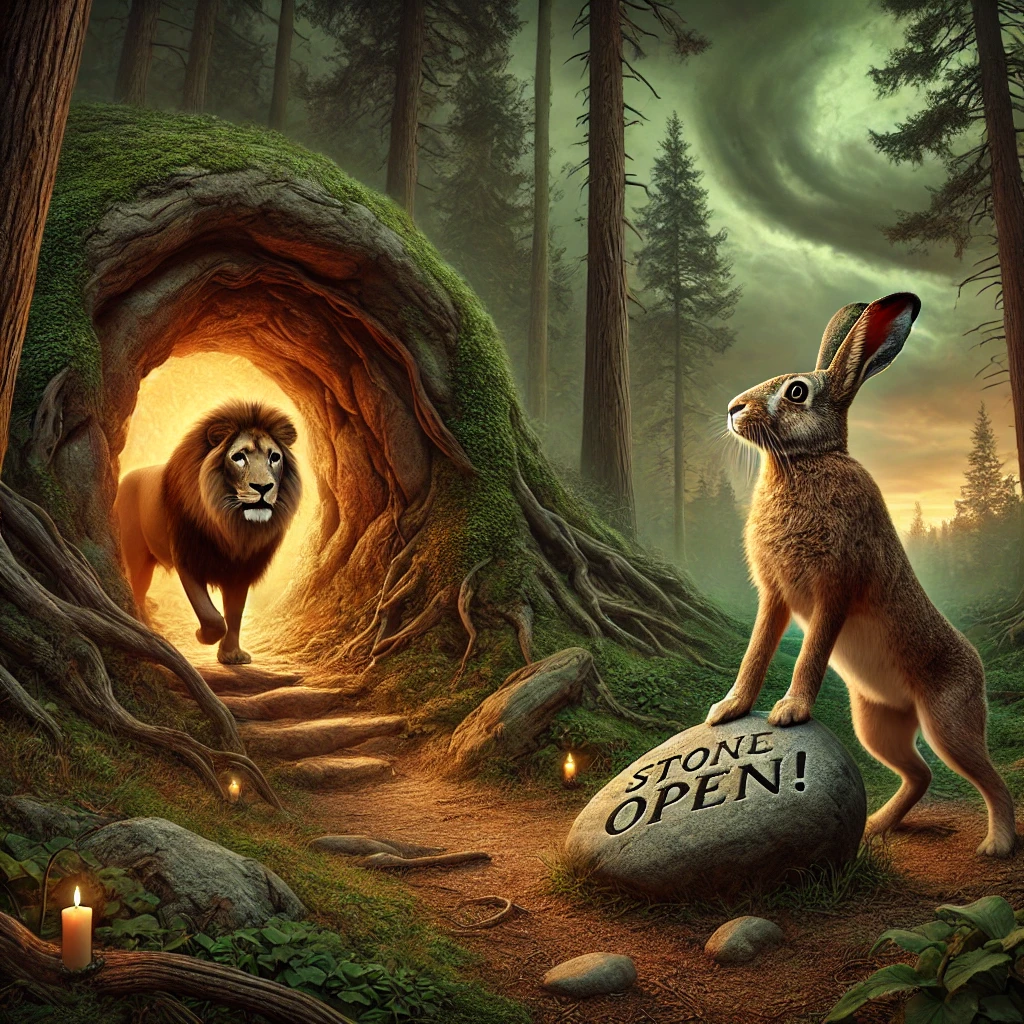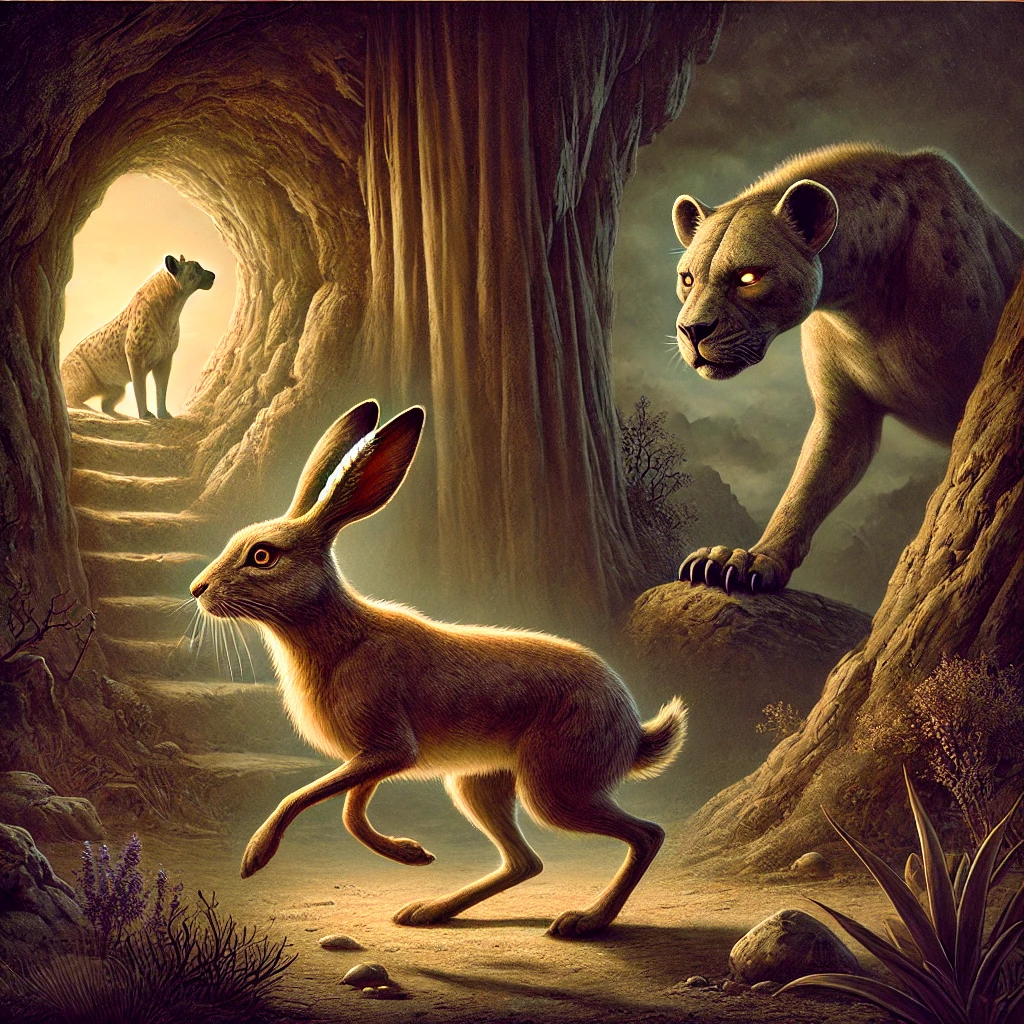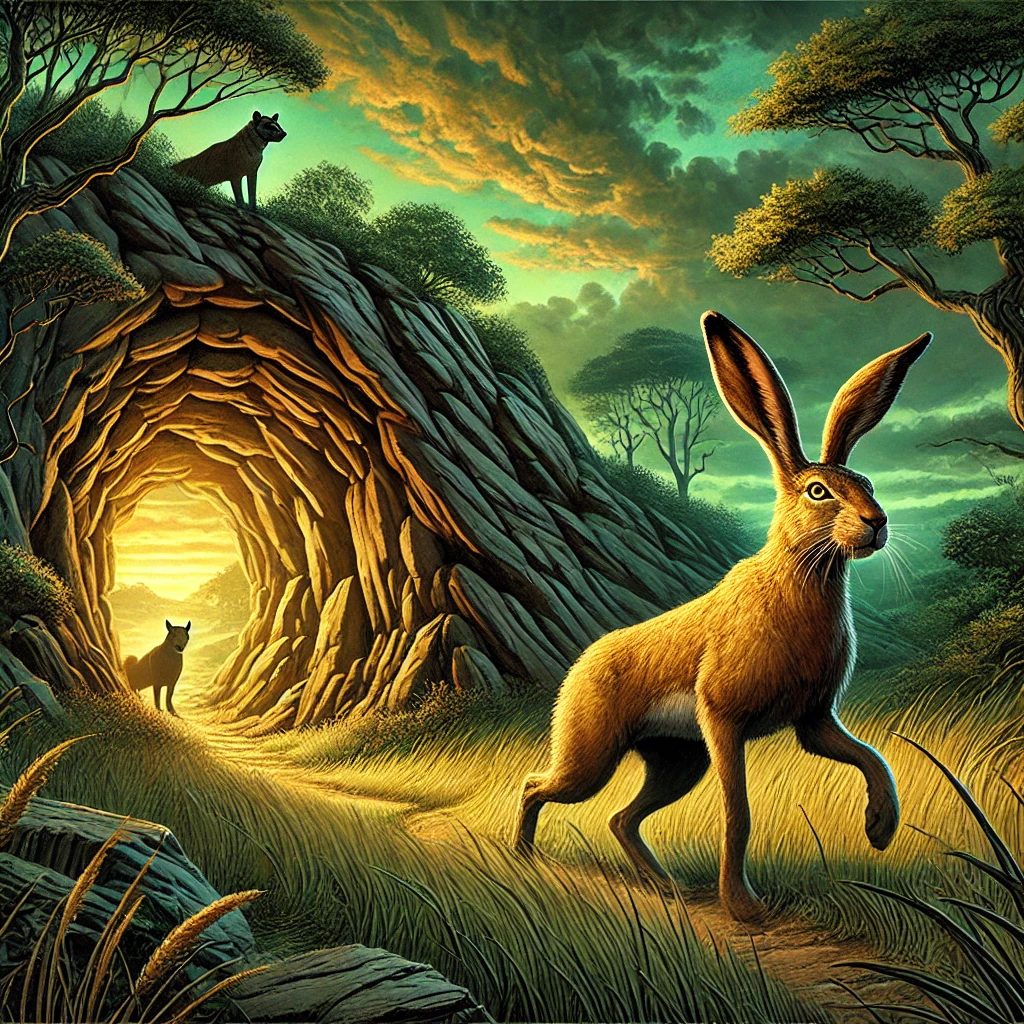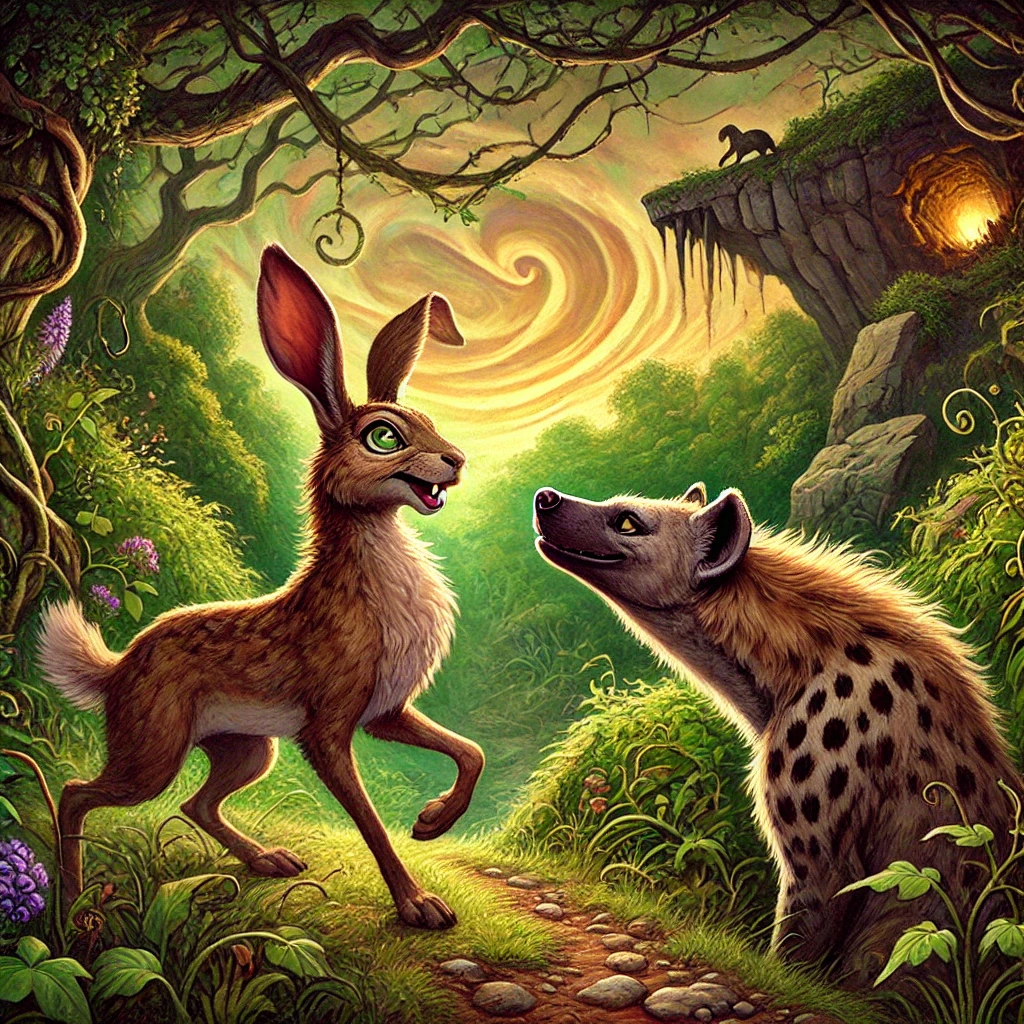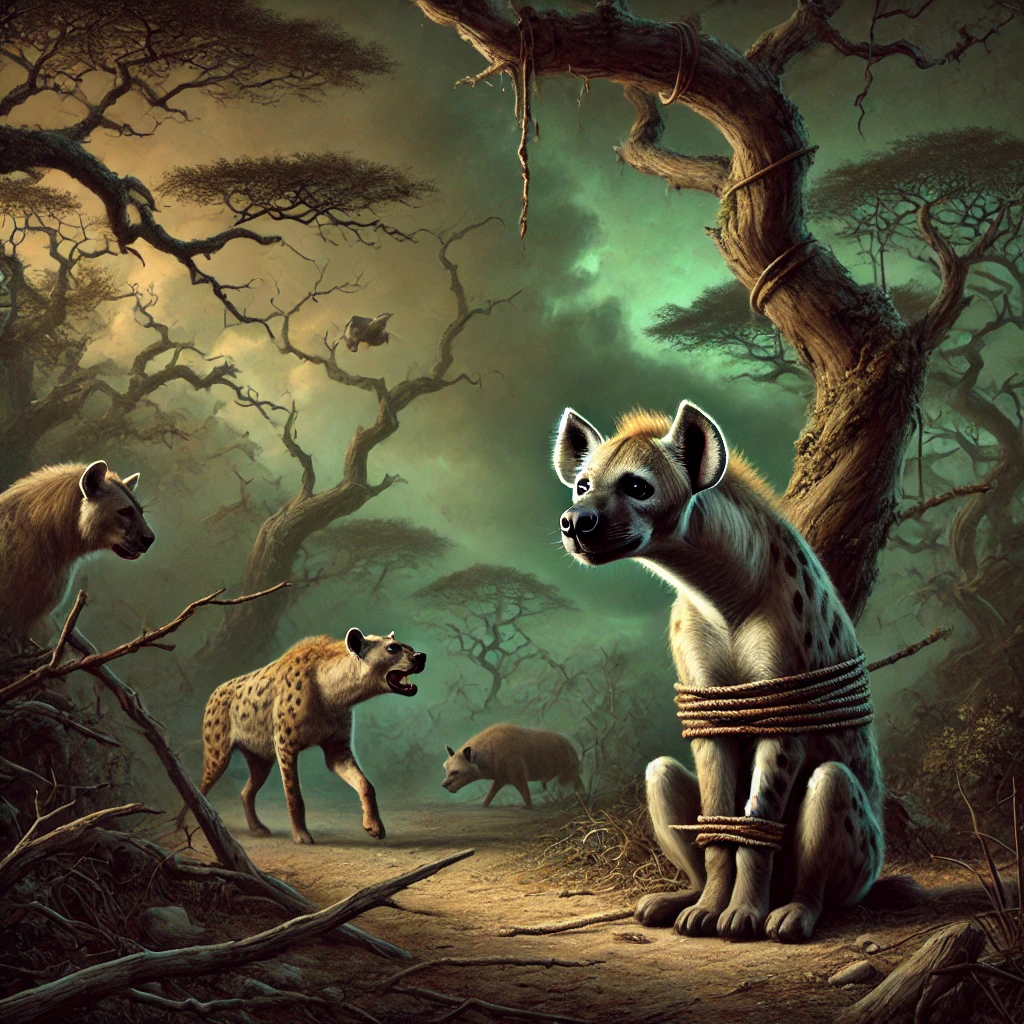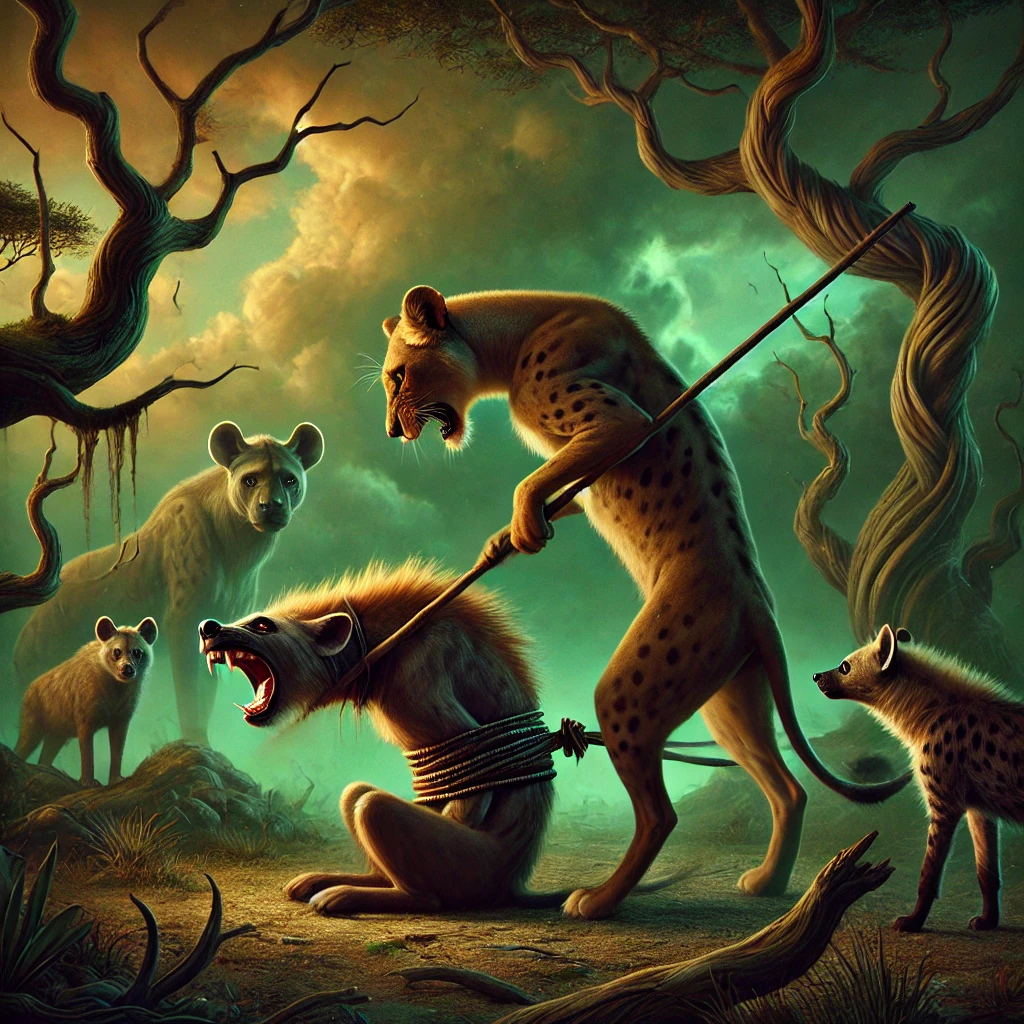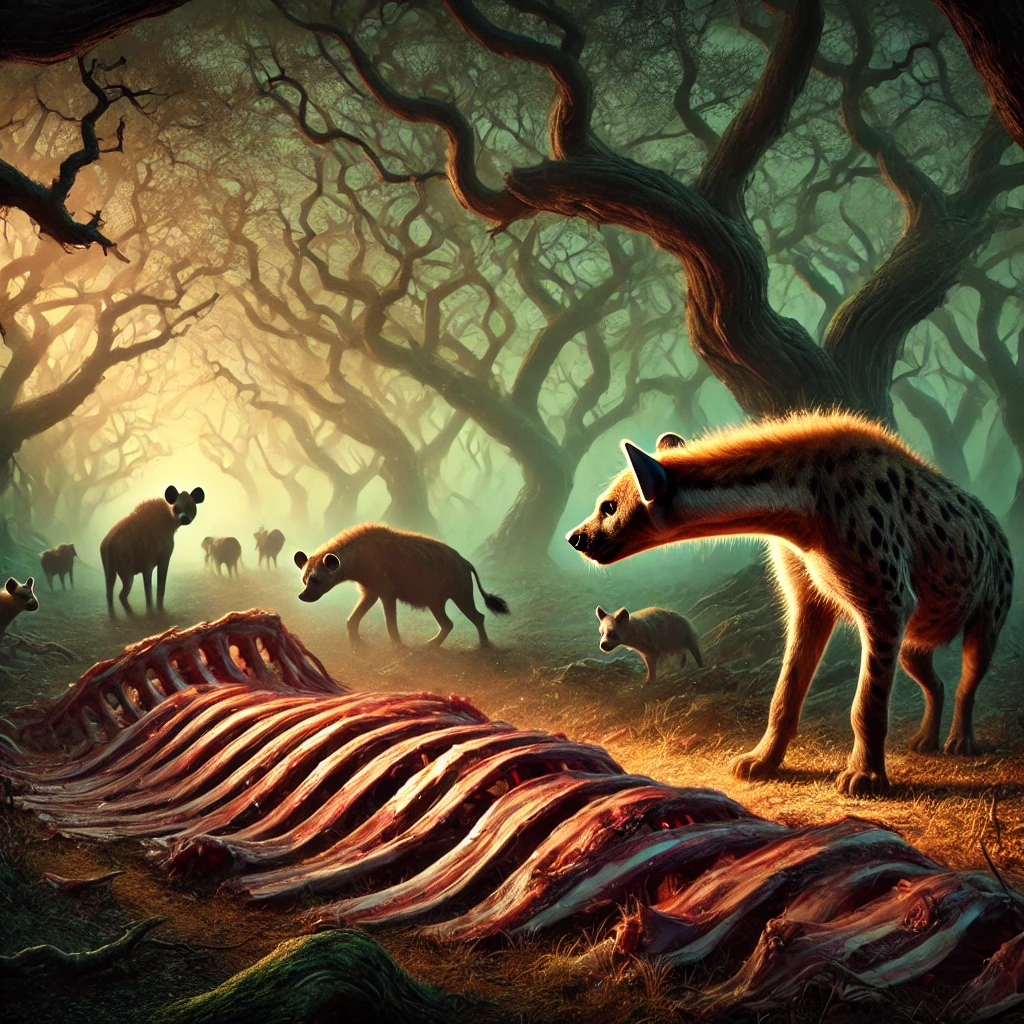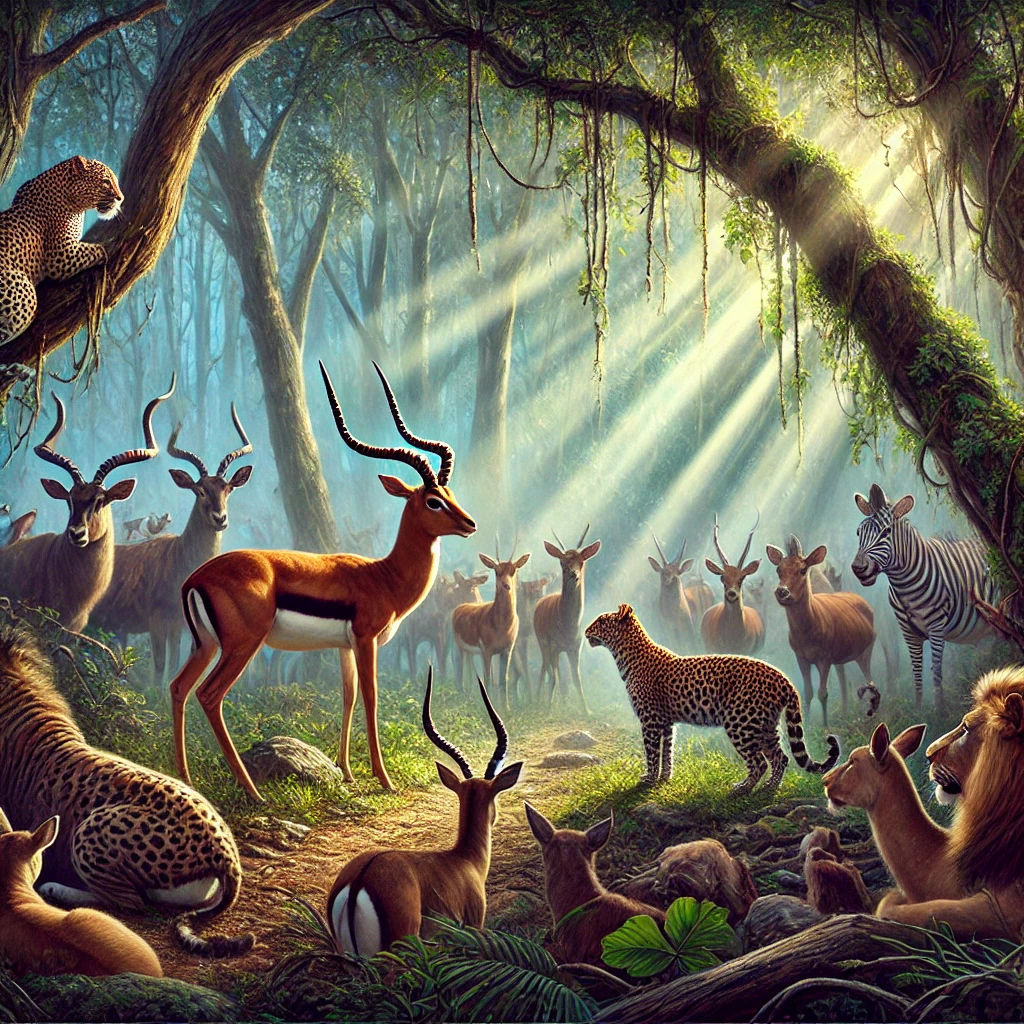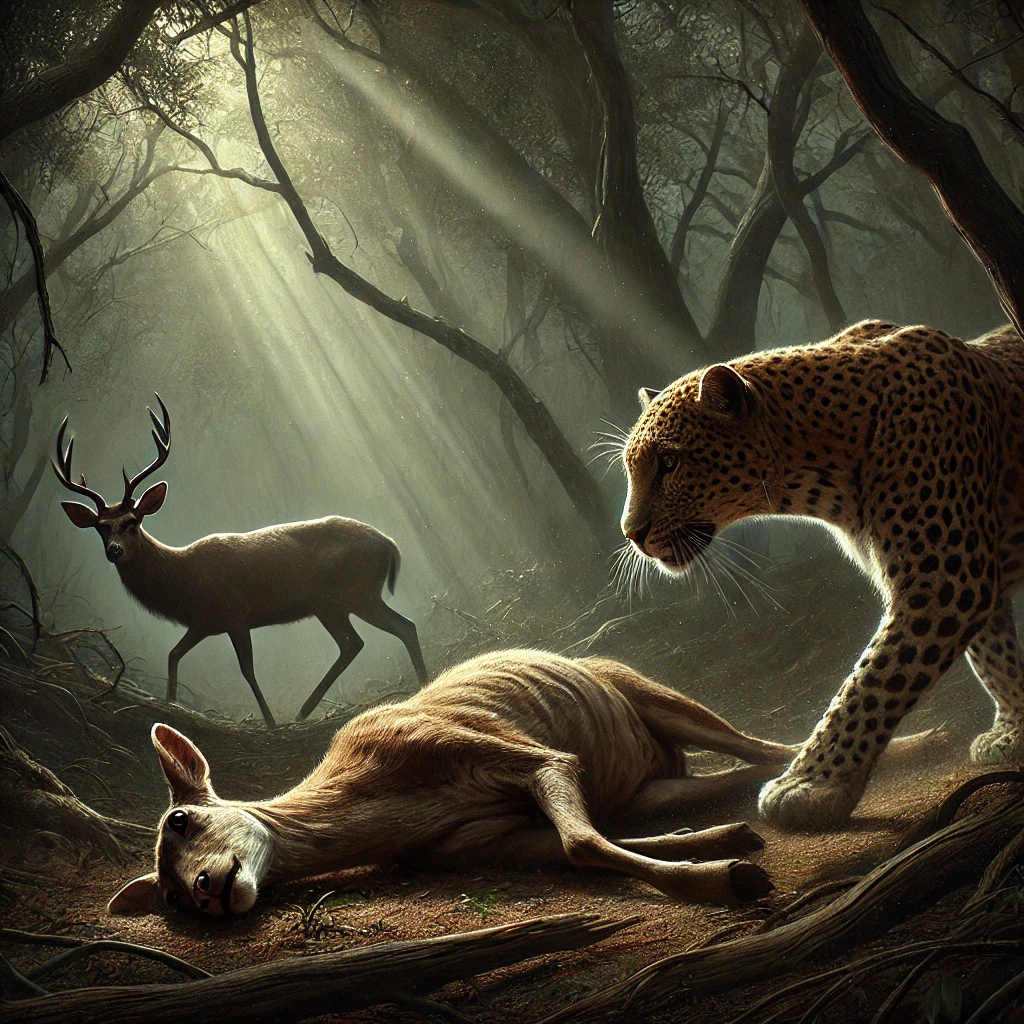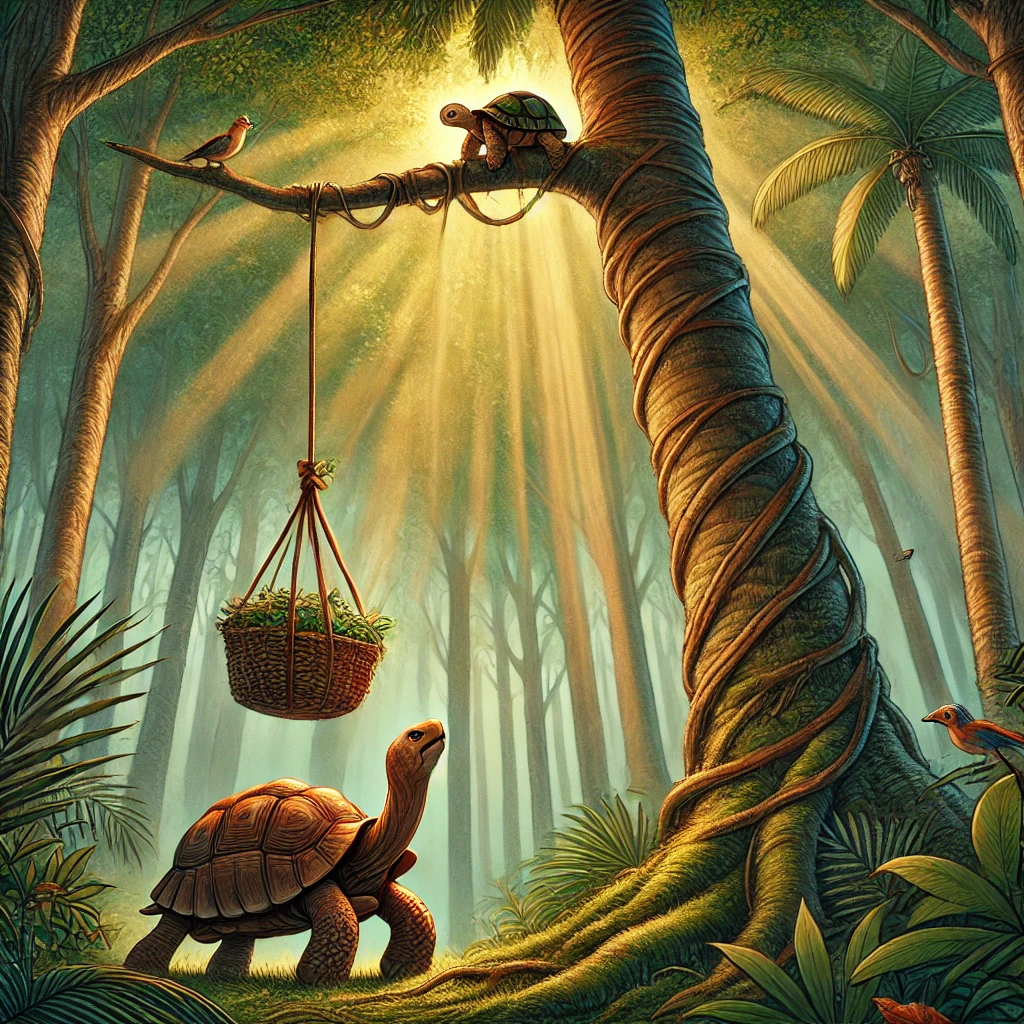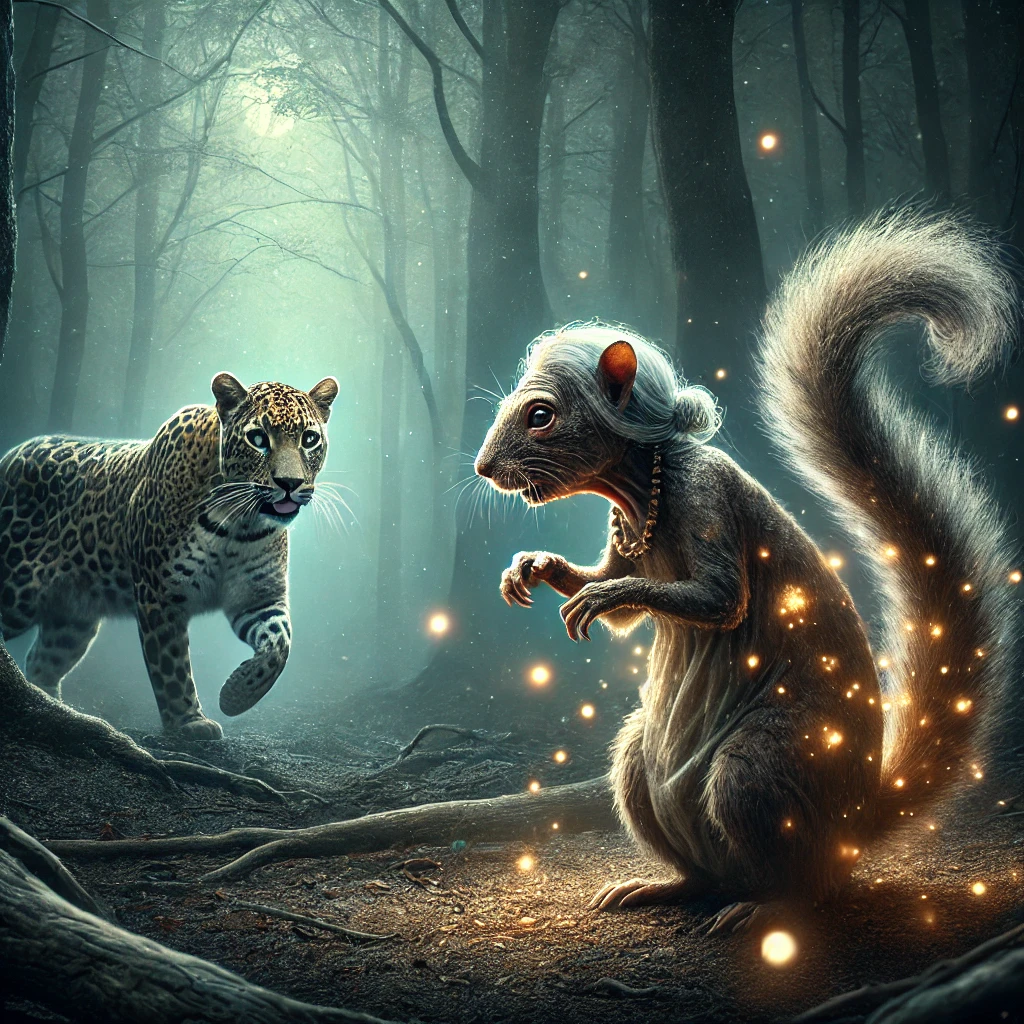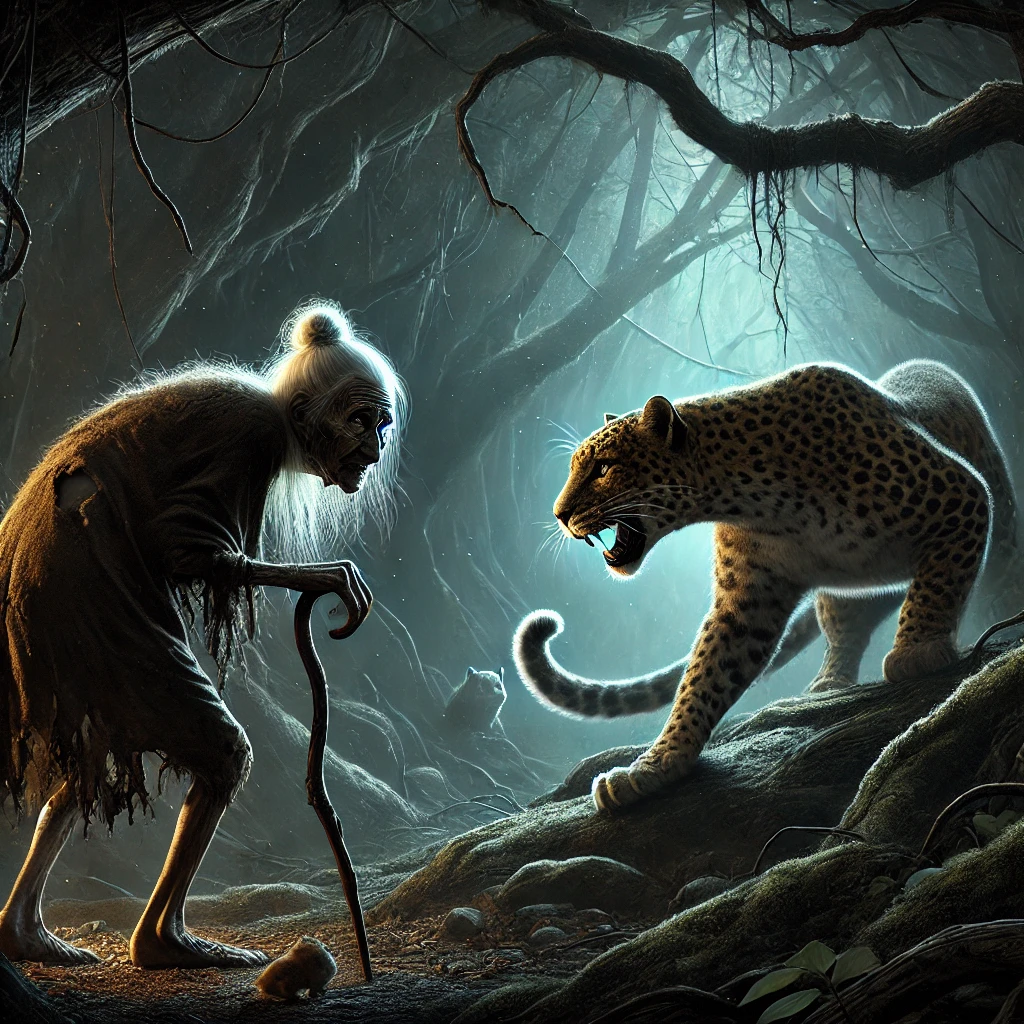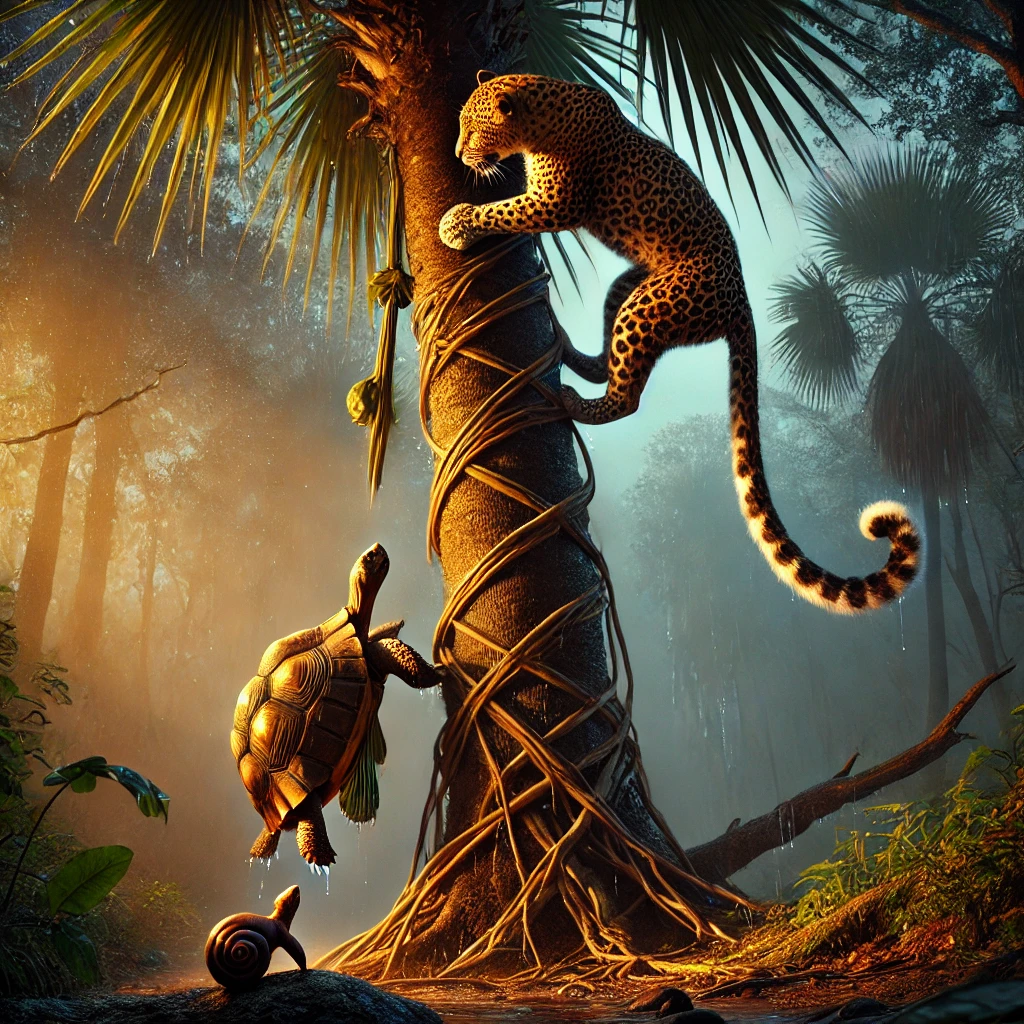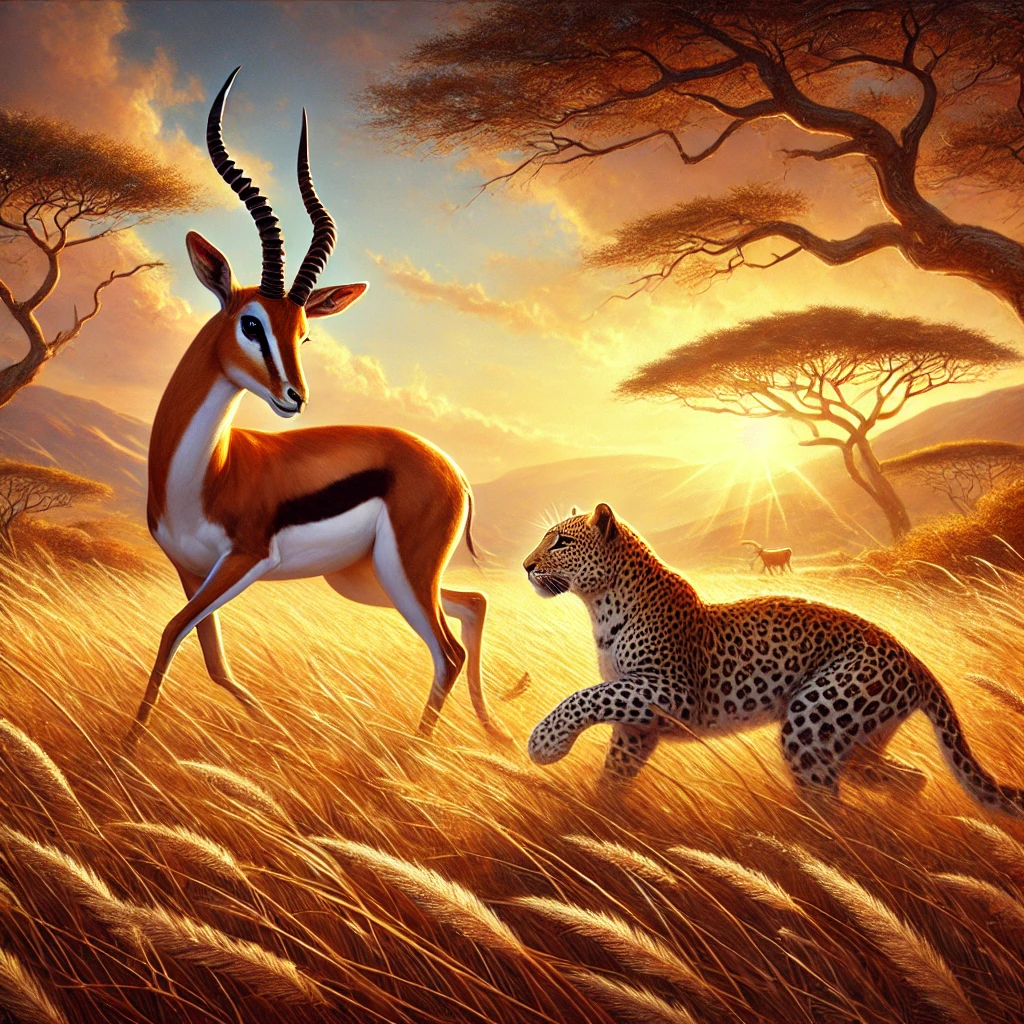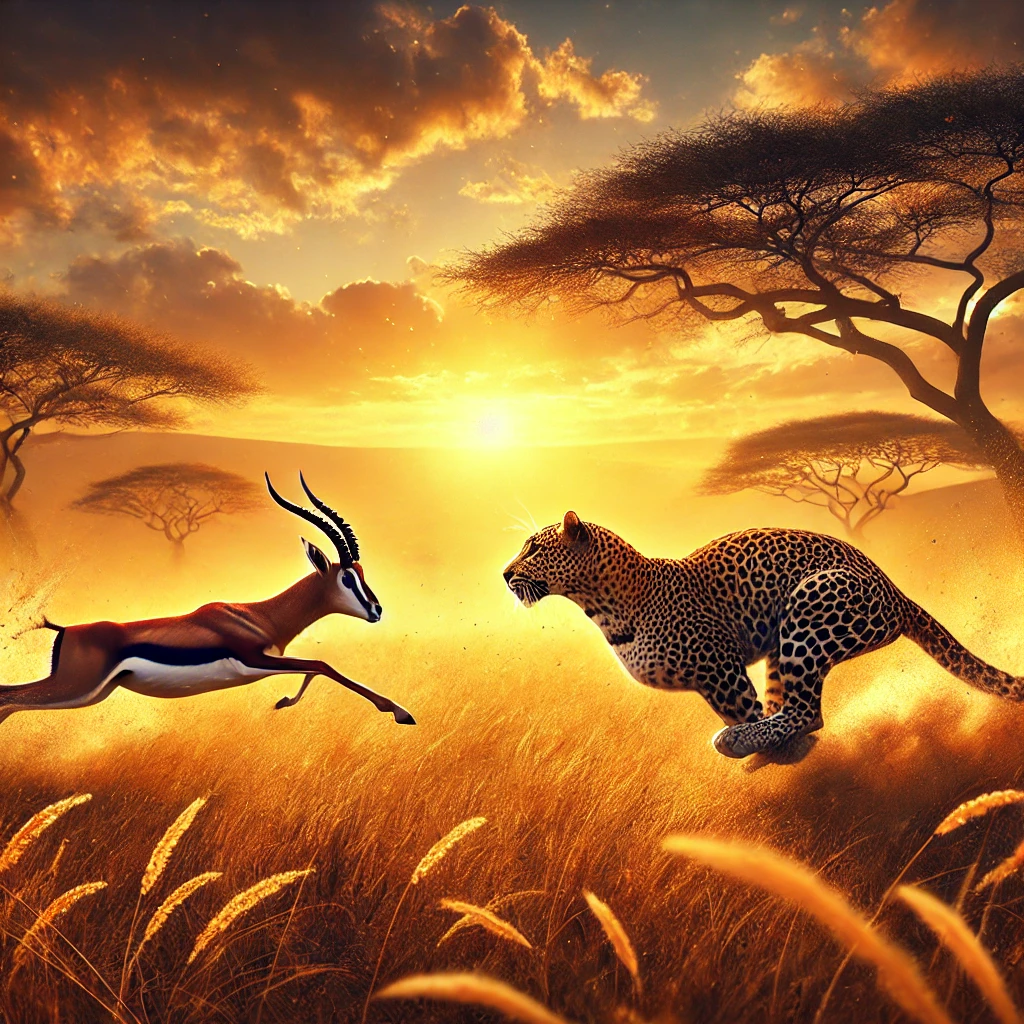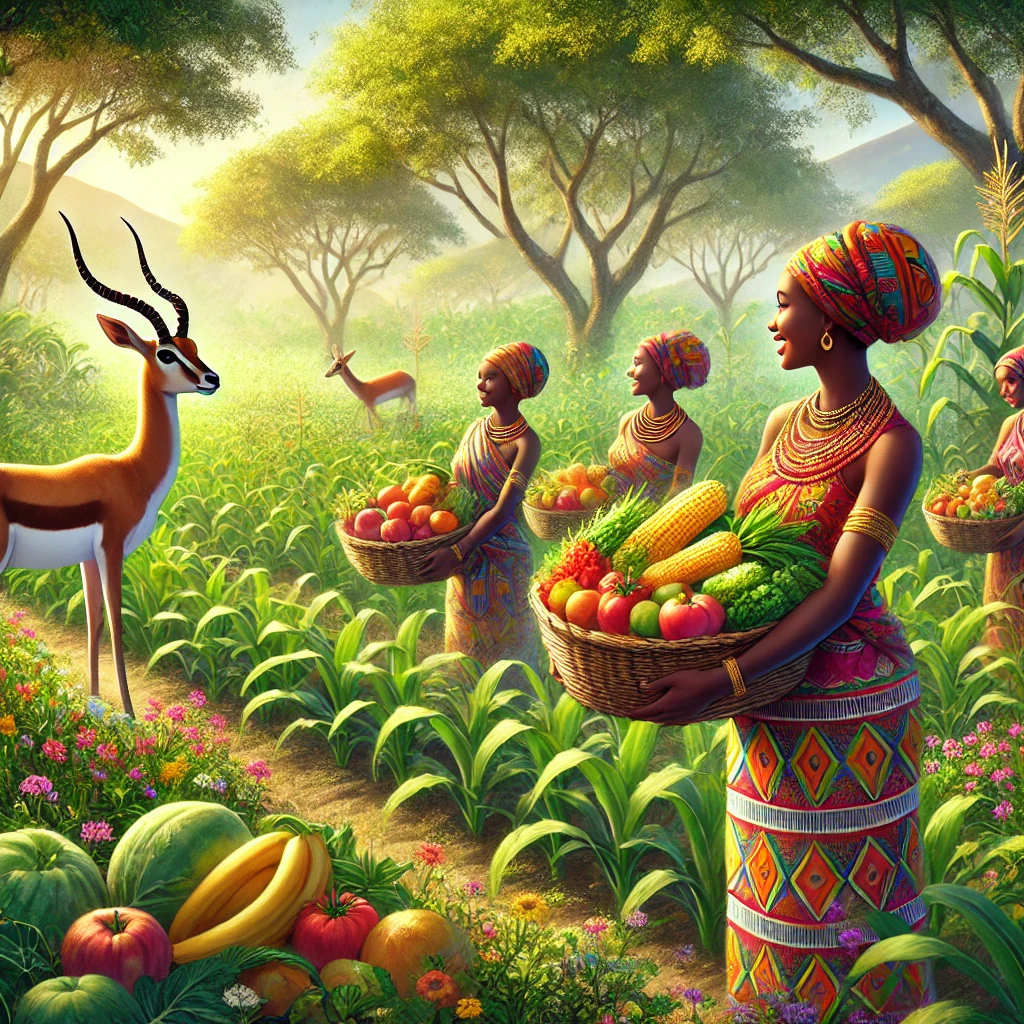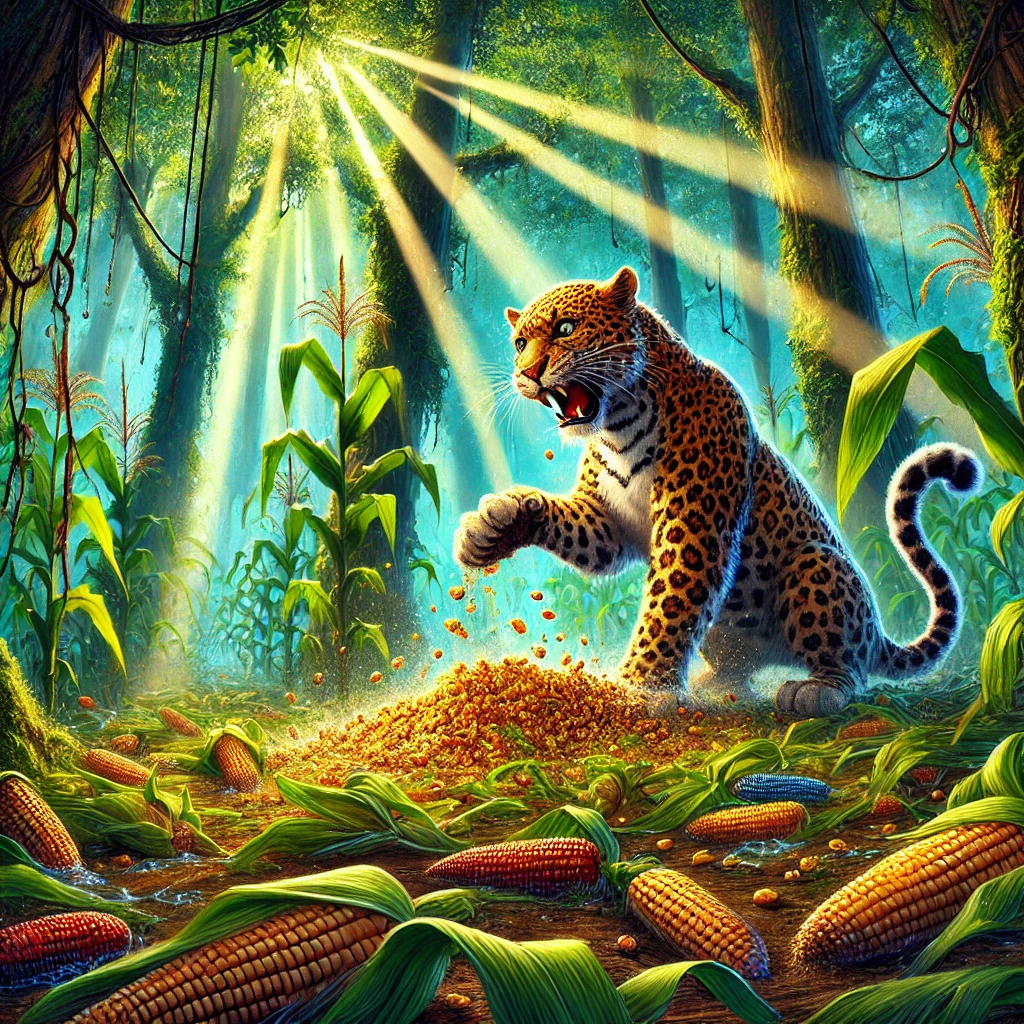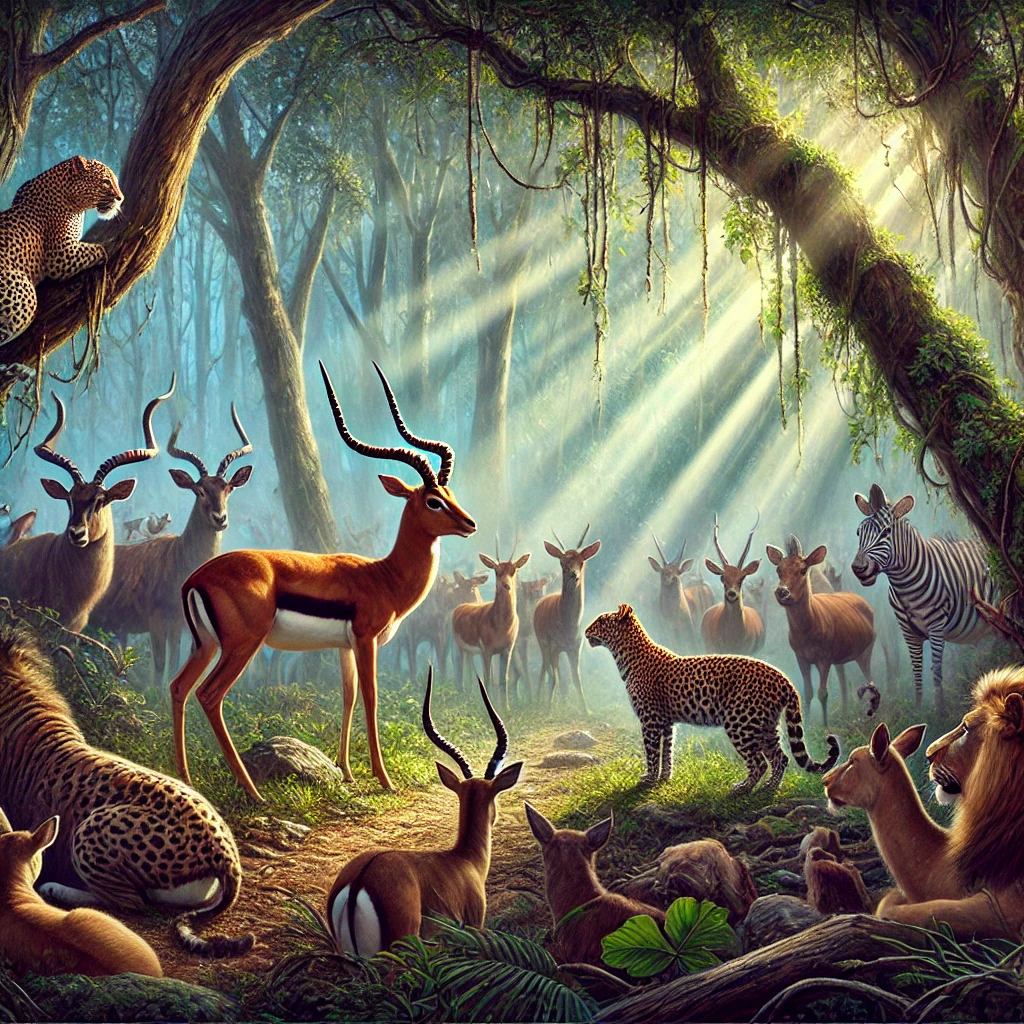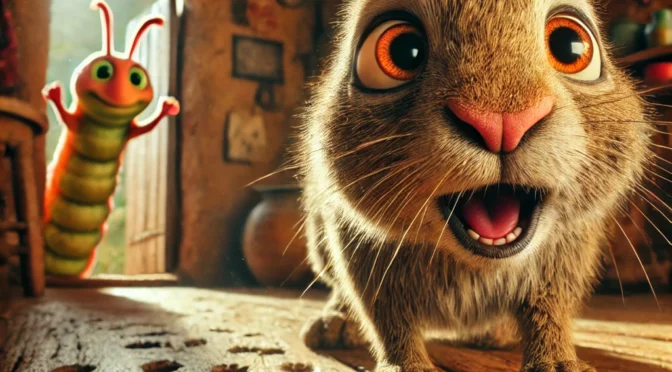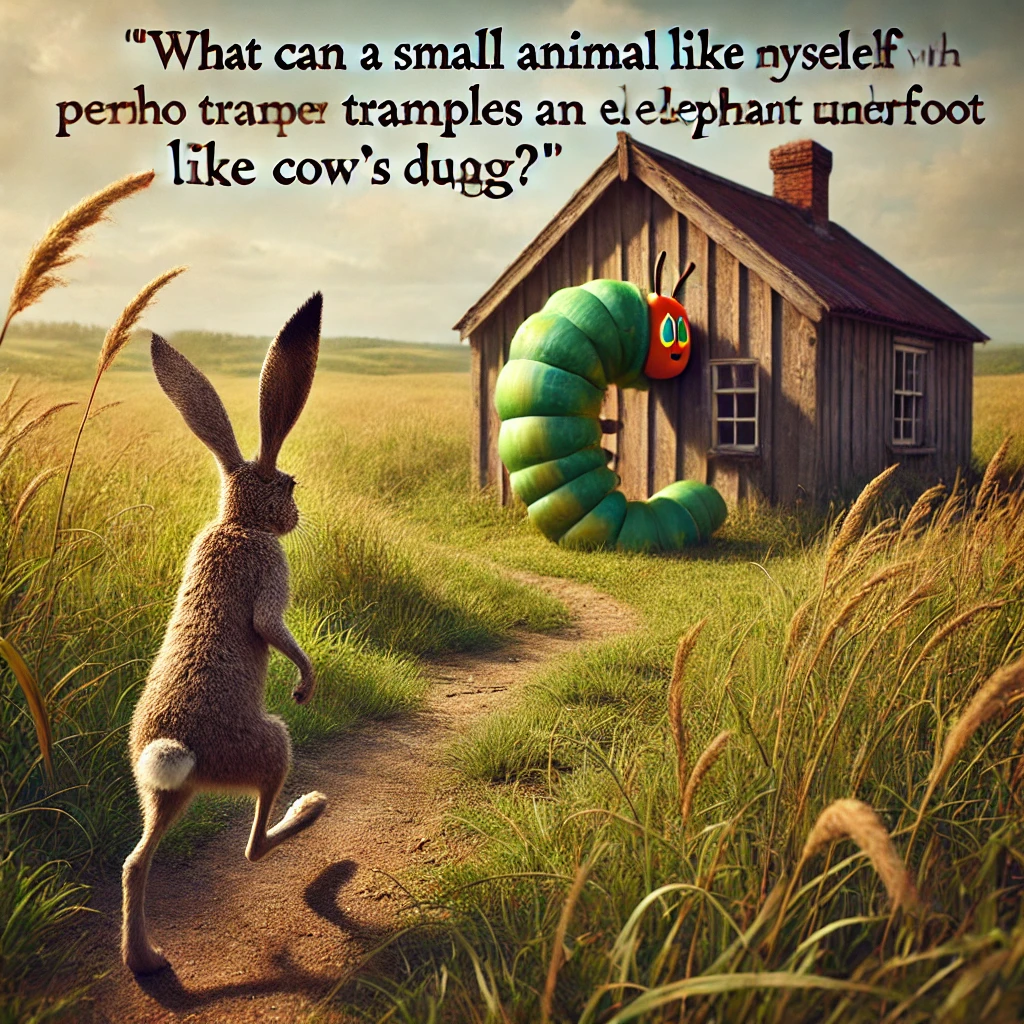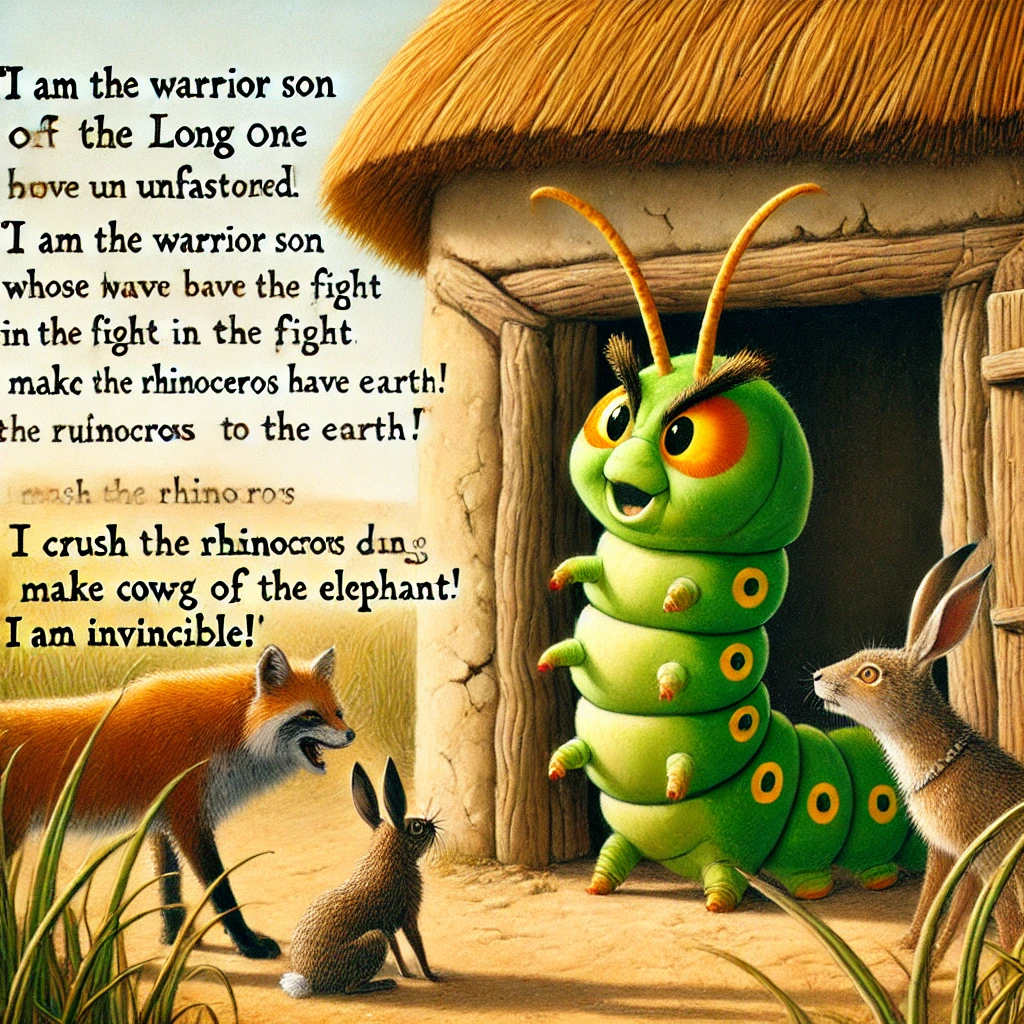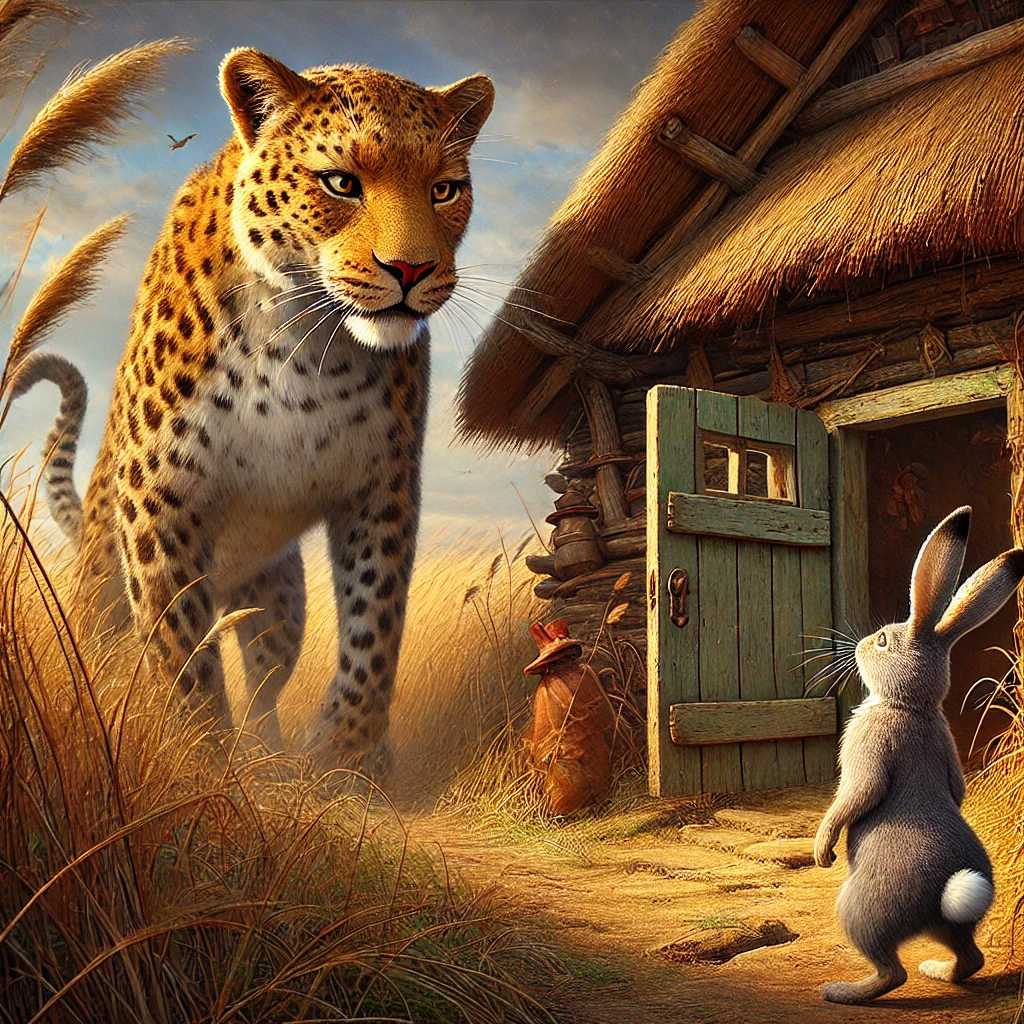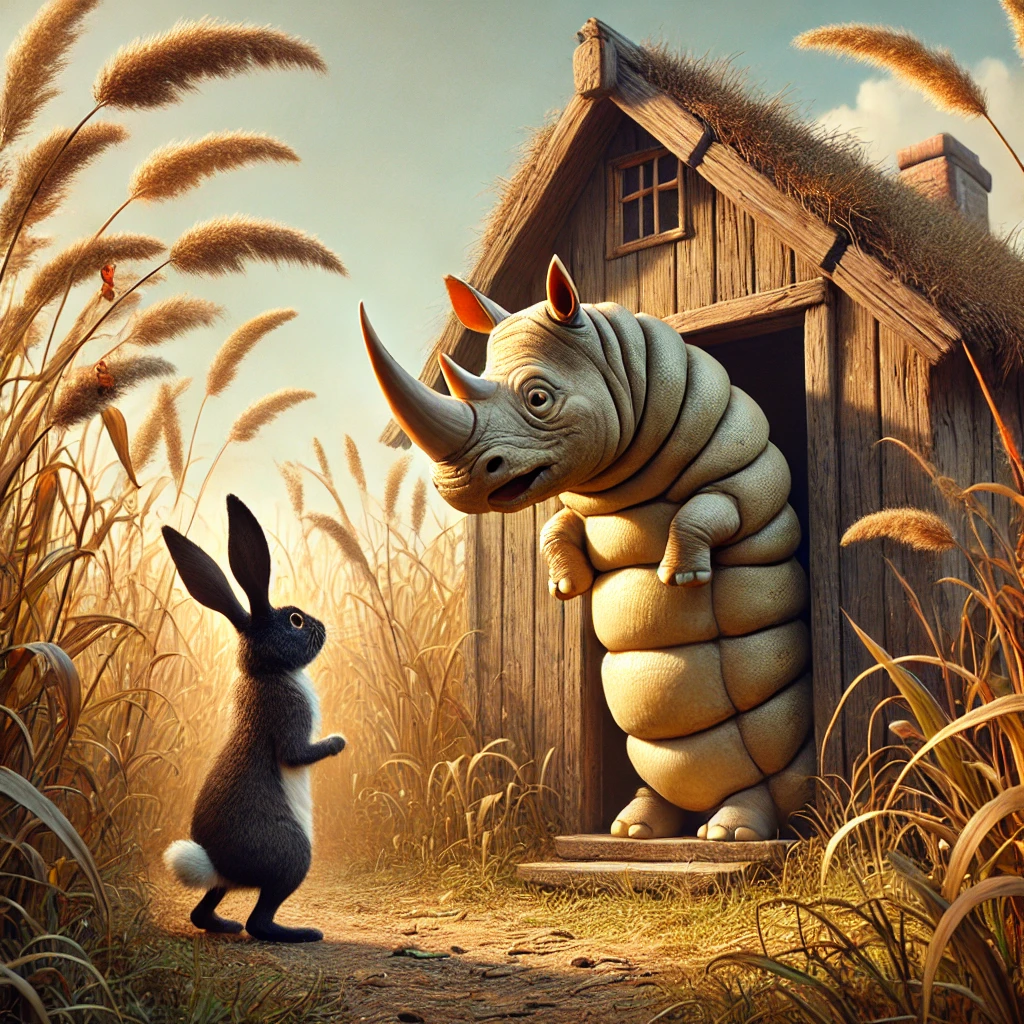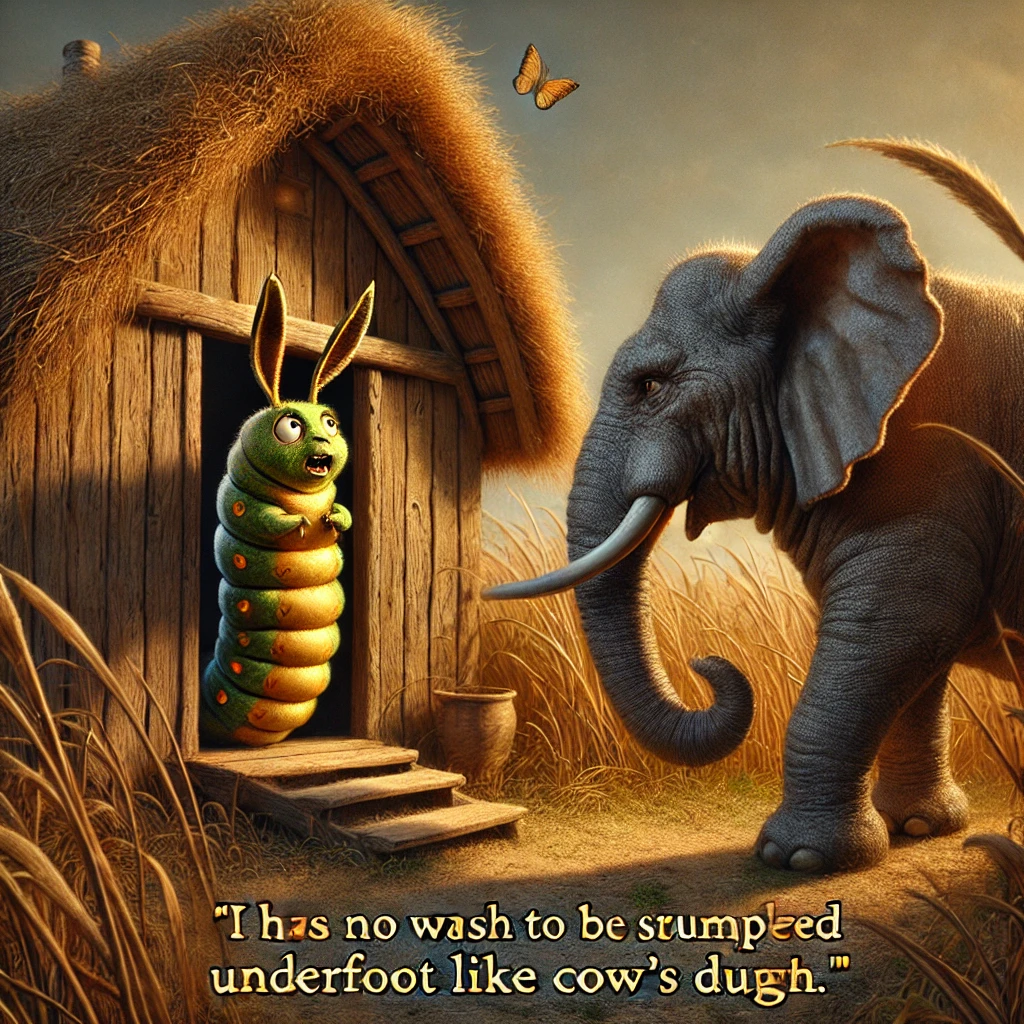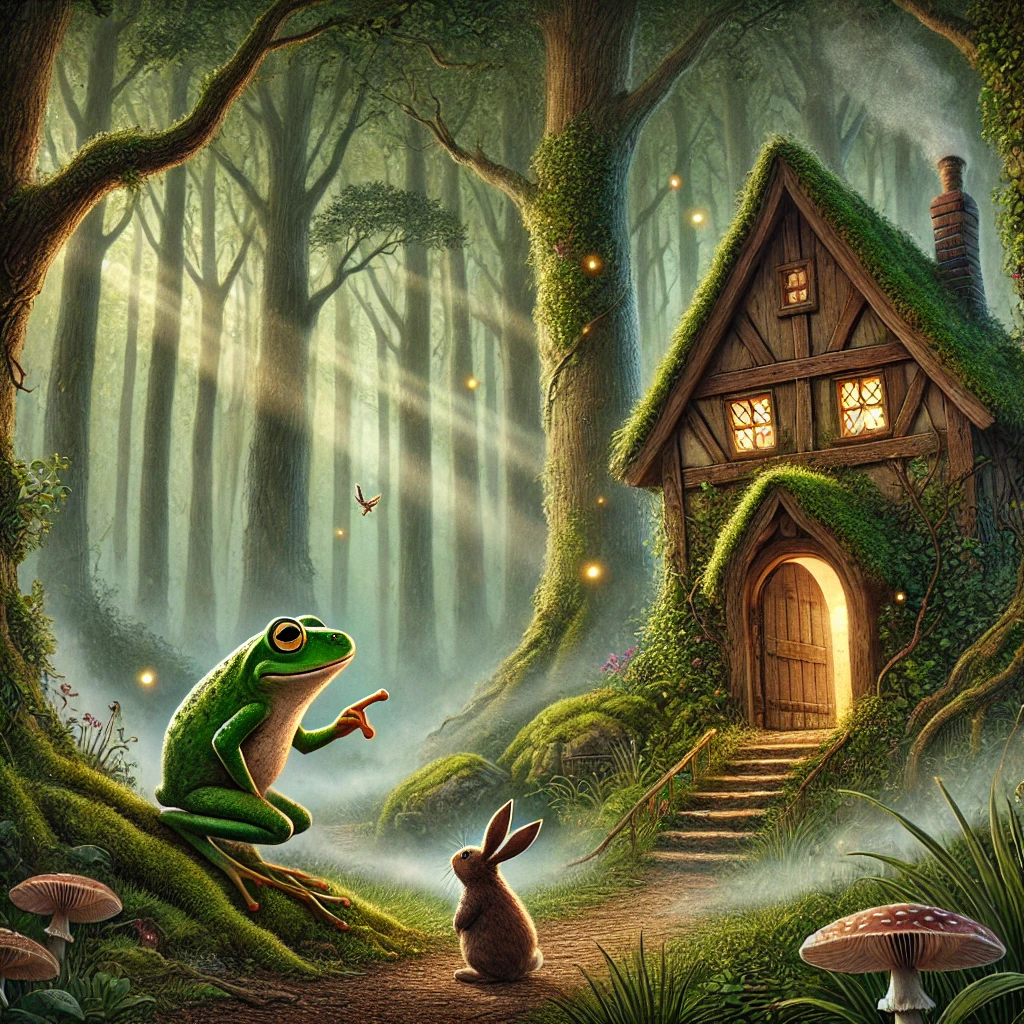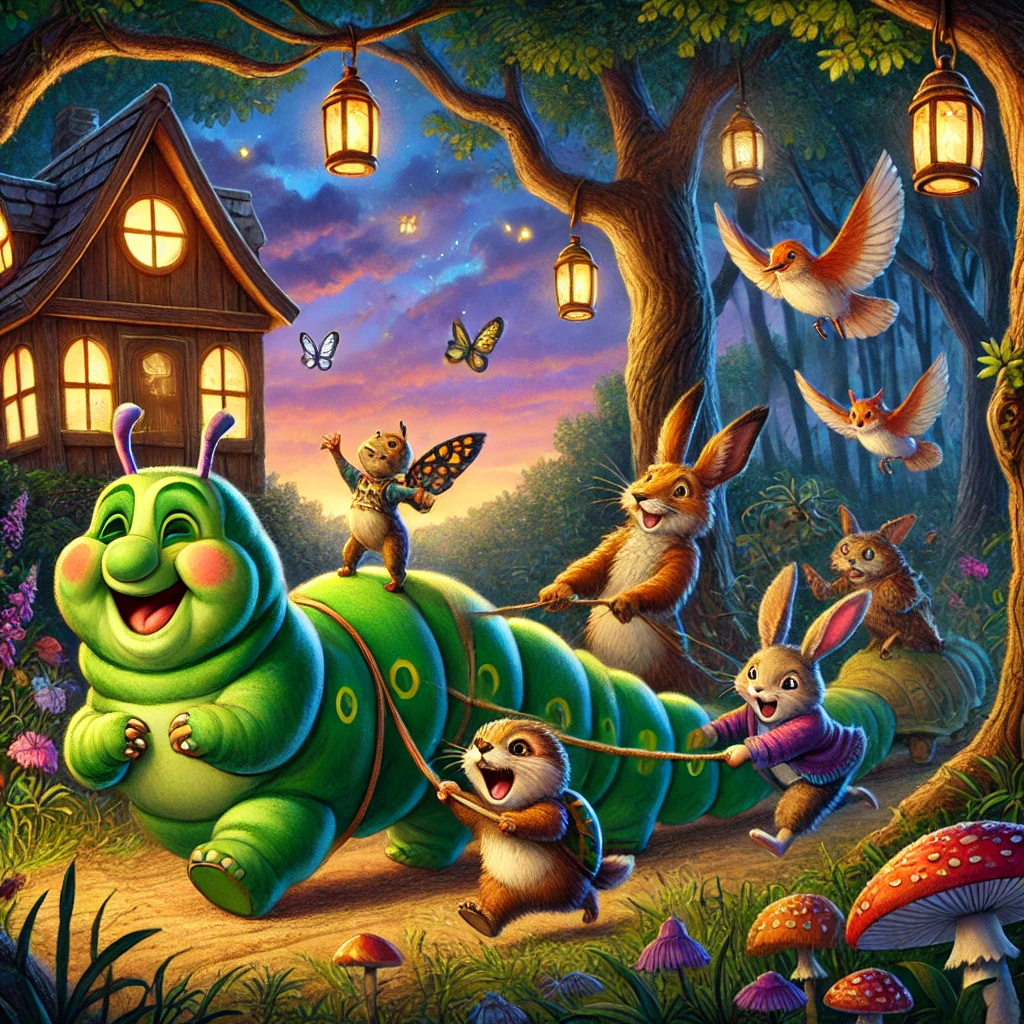Hare, that will trickster, went to live with Grey antelope. One day he said to her, “suppose we go and till our fields and plant some bean!” So off they went and set to work. Antelope stole Hare’s beans, and Hare stole Antelope’s beans, but did most of the stealing.
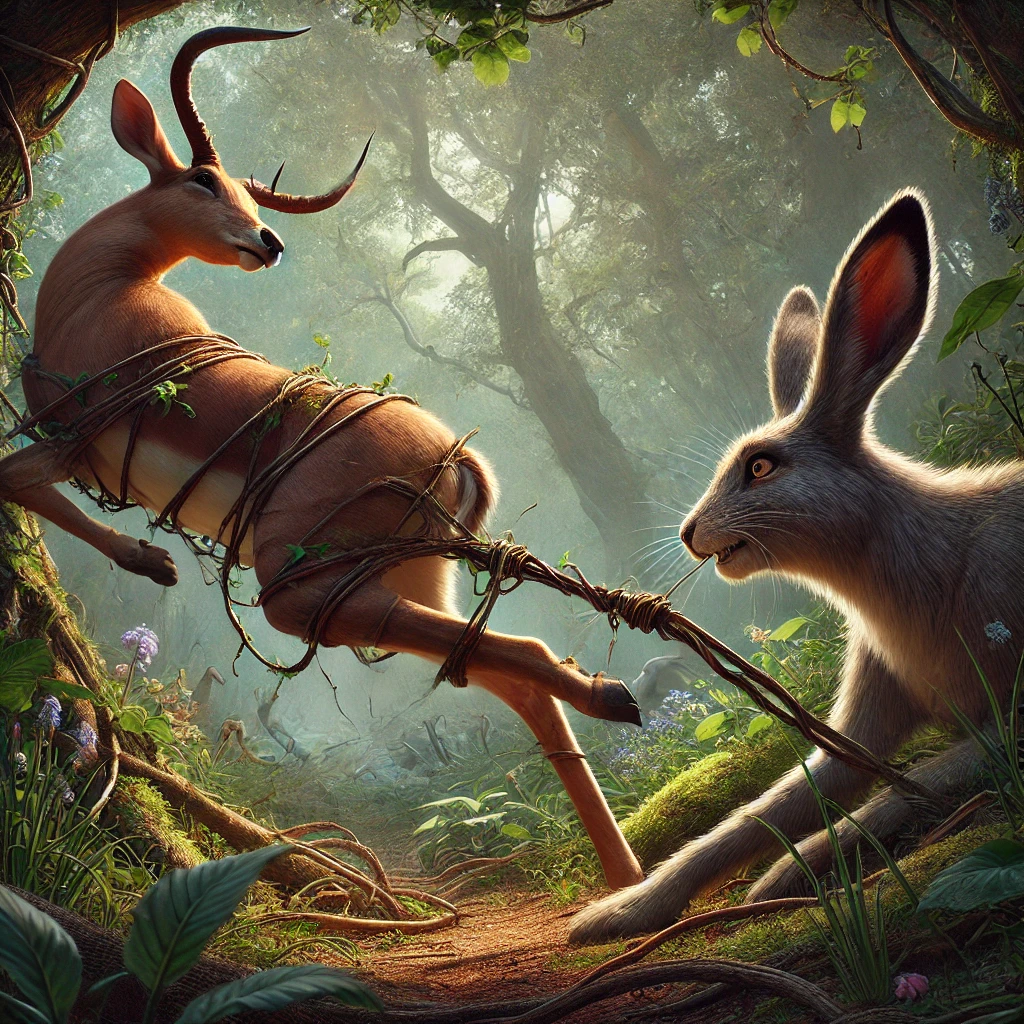
Hare set a trap in his field, and Antelope was caught by the leg. In the early morning the cunning rascal went out and found Antelope caught in the trap. “Don’t you think you deserve to be killed,” said he, “now that I have found you out?”
“No! No!” she cried. “Let me go, and we will go back to my house where I will give you a hoe.” So he let her go, and she gave him the hoe.
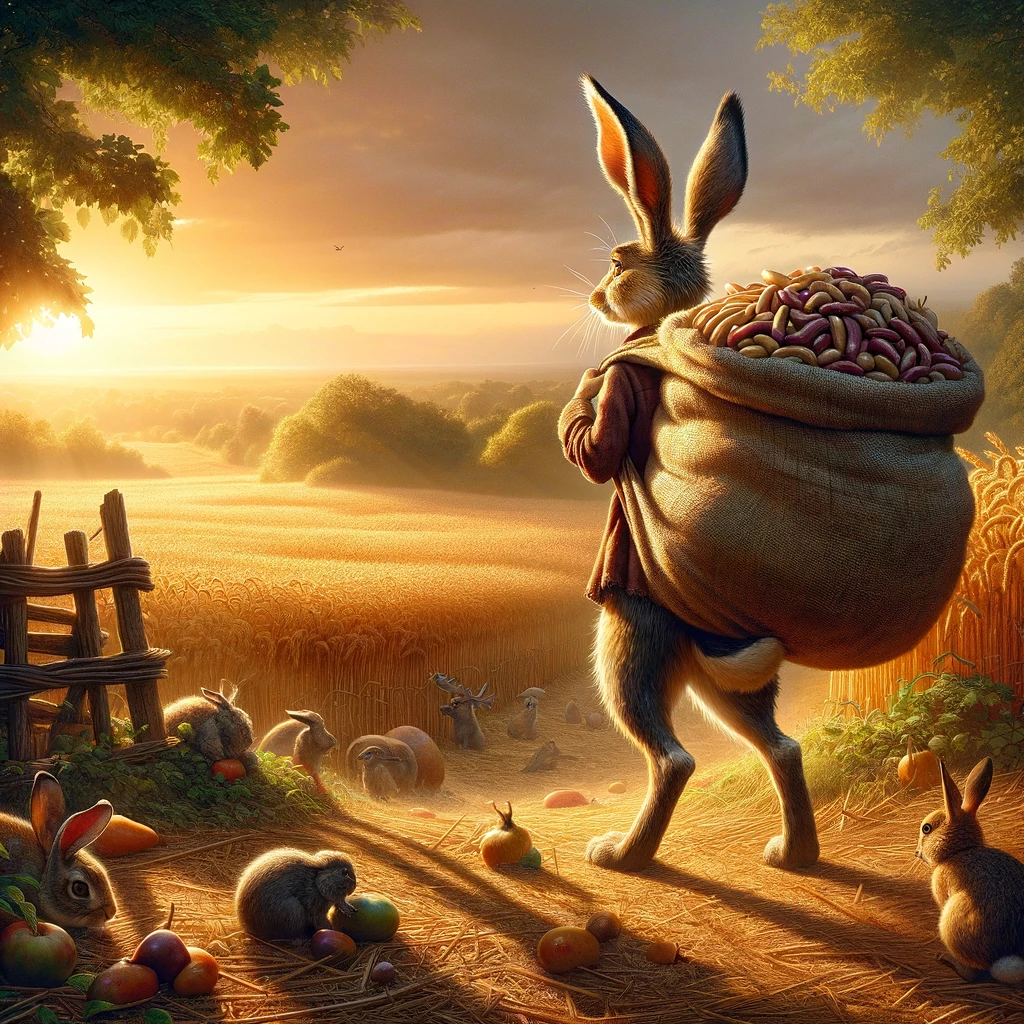
Hare then packed his beans, harvested all his fields, and made ready to be off. Good-bye,” he said to Antelope, “I won’t stay with you any longer. You are a thief!”

Hare soon came across the great lizard, Varan, lying at the edge of a water-hole. It was the chief’s water-hole, where they drew their water, and he had been placed there on guard to find out who it was that was continually disturbing it and making it muddy. “What are you doing here?” said Hare.
“I am watching this hole to see who it is that muddies the chief’s water.”
“I’ll tell you what,” said Hare, “we had much better go and till a field together.”

“How can I dig?” said Varan. “I can’t stand on my hind legs and hold the hoe in my forepaws.”
“That doesn’t matter! Just come long. I will tie the hoe to your tail and you will be able to dig beautifully.”

So the hoe was tied on, but when this was done Varan could not move. Then Hare ran back to the hole, drank his fill of water, and finished by stirring it up well, making it as muddy as possible. After this he walked all over Varan’s fields and regaled himself on his groundnuts. In the heat of the day he came back and said, “Ho! An army has passed through the country. I hear that the warriors have dirtied the water in the hole. I hear, too, that they have ravaged all your crop of groundnuts!”
“Untie me!” said Varan. “I can’t budge.”
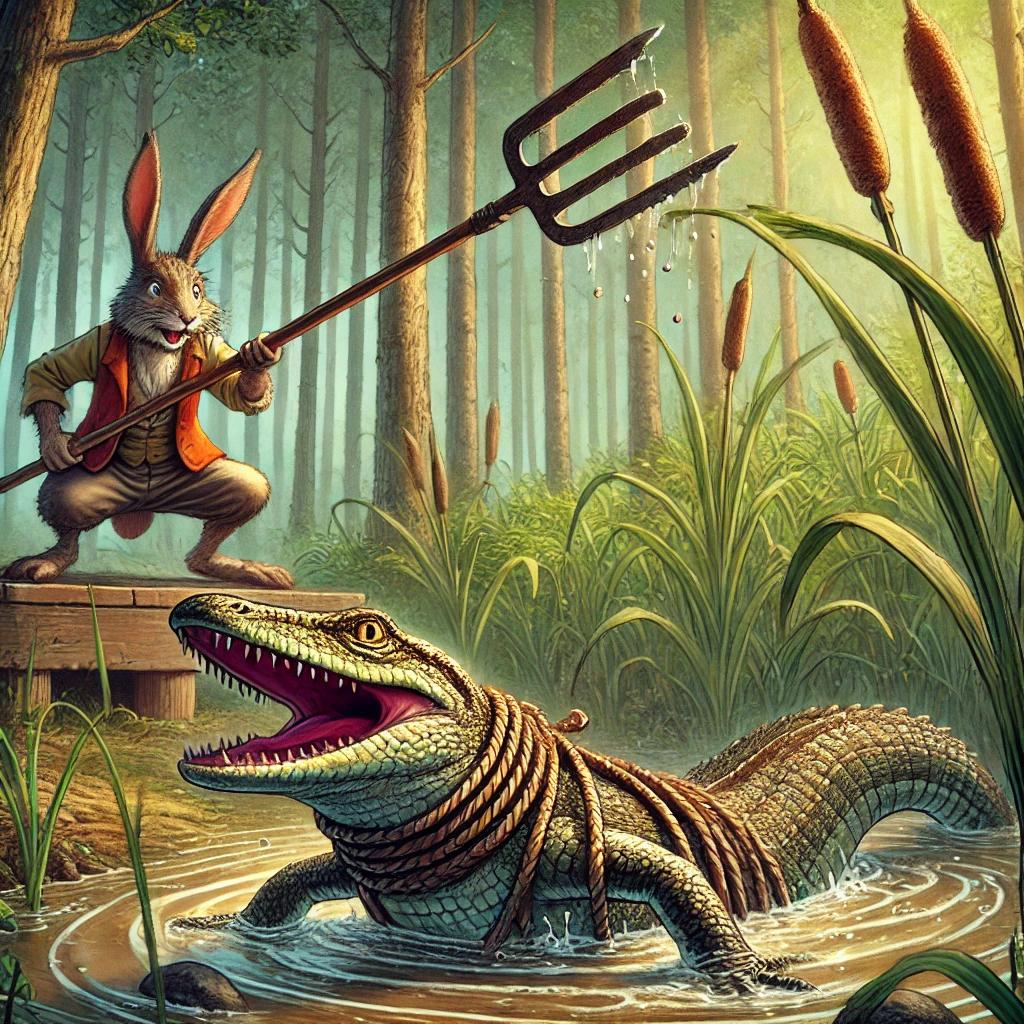
“All right, but only on condition that you don’t go and accuse me, Hare, of having stirred up the water.”
“But who told you this story about those soldiers who did all the mischief?”
“Don’t ask me so many questions. If you do, I won’t untie you!”
“Very well! I’ll be quiet, but take away this hoe. It hurts me!”
“Listen! First of all, I’ll go and draw some water for you. You must be thirsty.”
“No, I’m not thirsty. Only let me go!’
“If you are not thirsty, all right! I won’t untie the hoe.”
“Oh, very well, I am thirsty. Hurry up, and come back as fast as you can.”
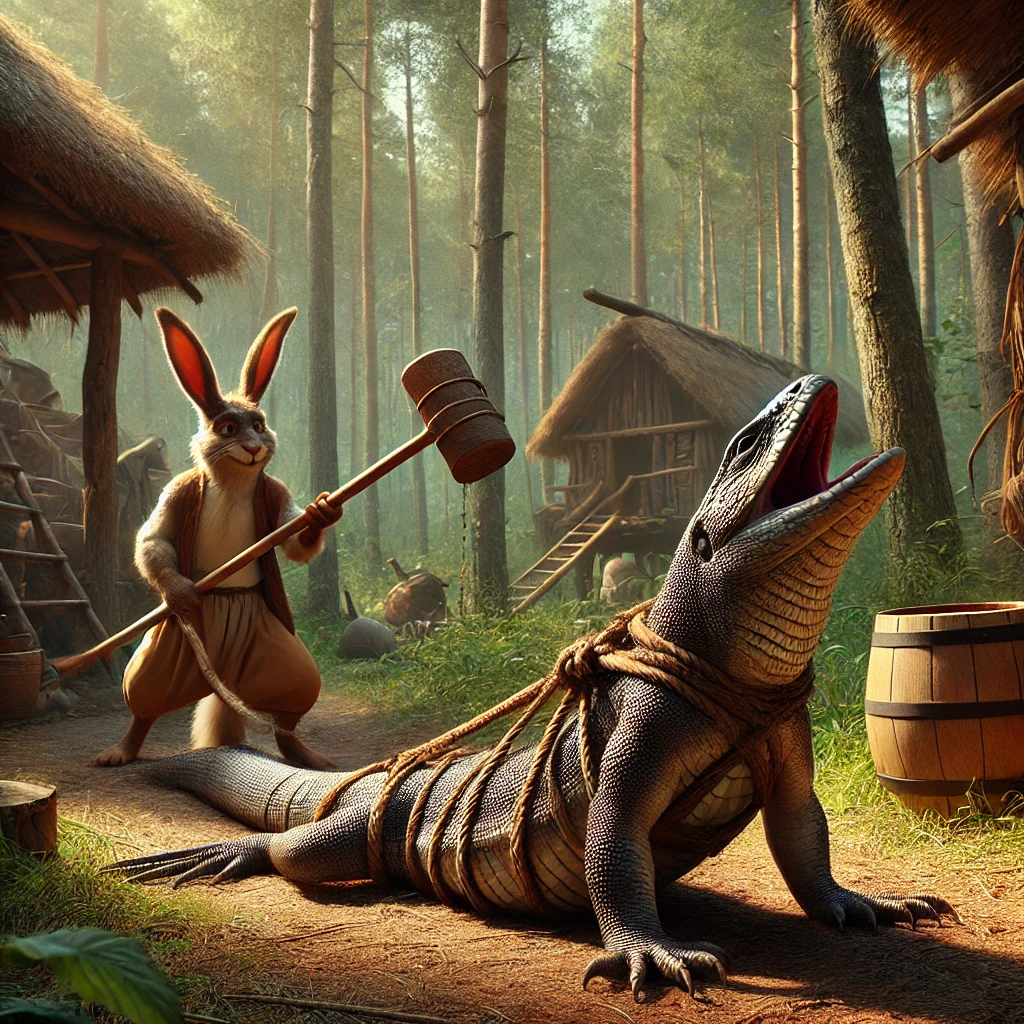
Hare went to Varan’s village, took the wooden goblet from which he always drank, drew some water, and once again stirred up the hole. He took a drink to Varan, and said to him, “If anyone asks you whether I have disturbed the water, you must say that you did it. If you don’t promise me this, I won’t untie you.”
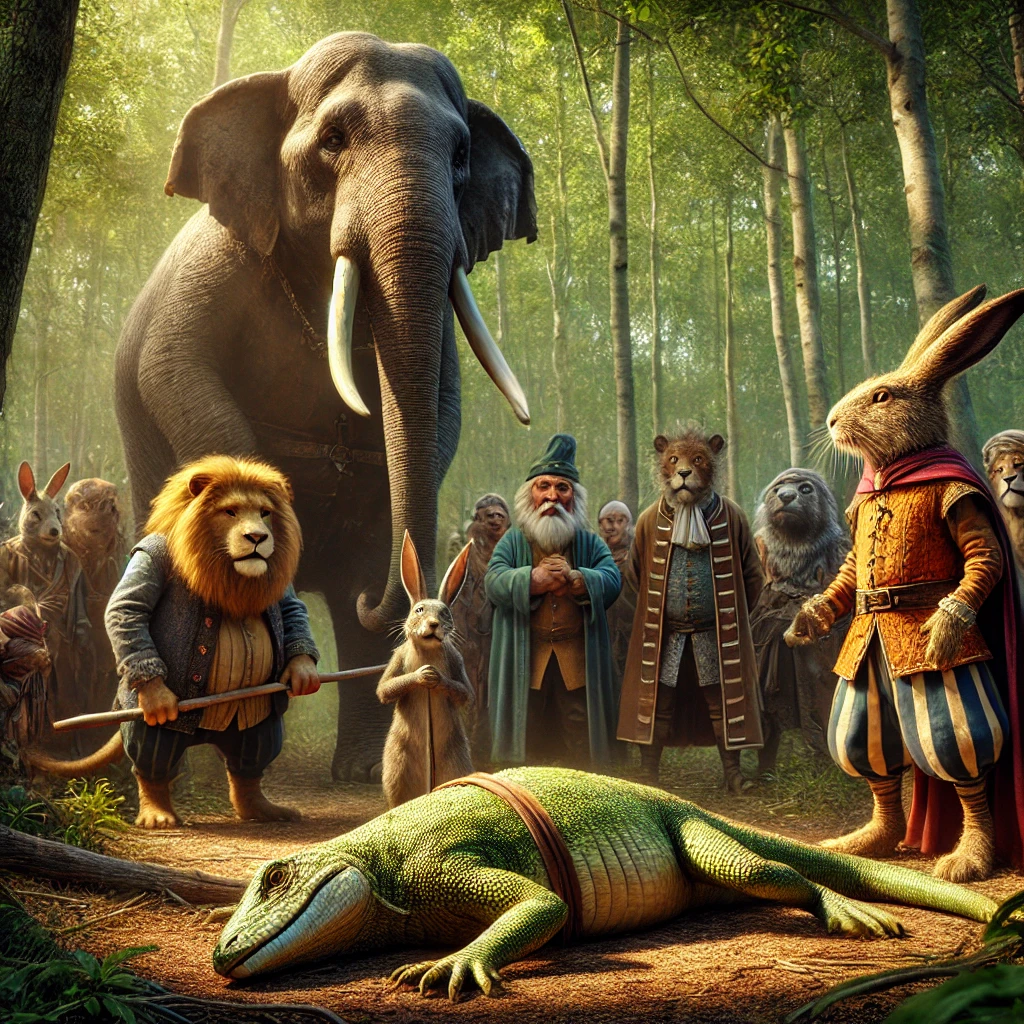
“All right. Very well.”
Then Hare ran to call the chiefs – Lord Elephant, Lord Lion, and the rest. They all came and asked Varan, “Who has been drawing our water and making it muddy?”
“It is I, said Varan.

And Hare, the rascal, added, “Yes, I found him committing this crime and I tied him up to a hoe, so that he couldn’t run away.”
The chiefs congratulated Hare. “Ah! you have been very clever! You have discovered the villain who has been muddying our pool!” And they immediately killed Varan.
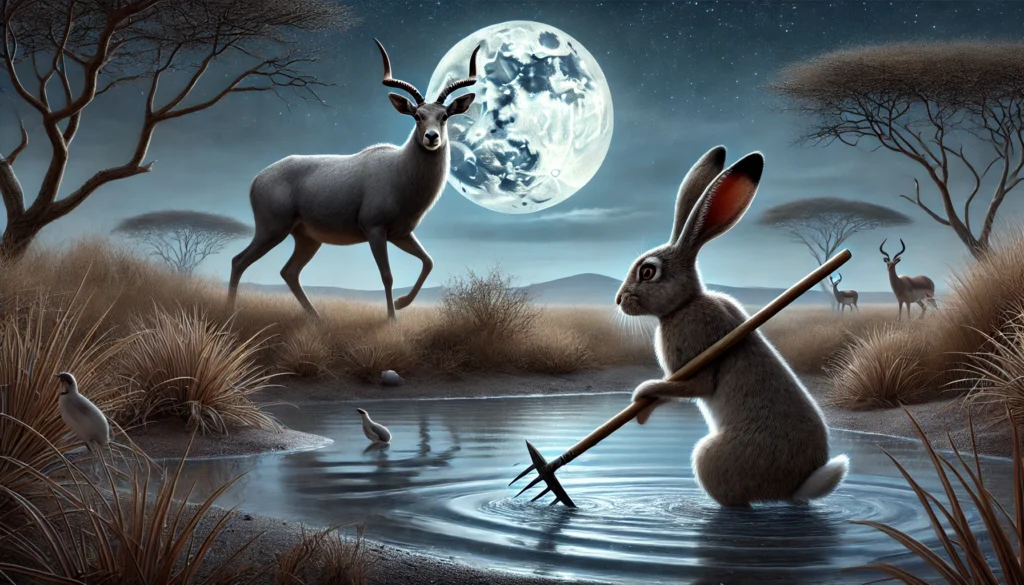
The wily trickster, Hare, took the hoe and then went to look for Grey Antelope. She was on sentry duty, on the edge of a pool, for guards were placed at all the pools to prevent anyone from approaching, as the water still continued to be muddied during the night. Hare, not being able to get anything to drink, said to antelope, “What are you doing there so close to the water?”
“I am guarding the chief’s pool.”
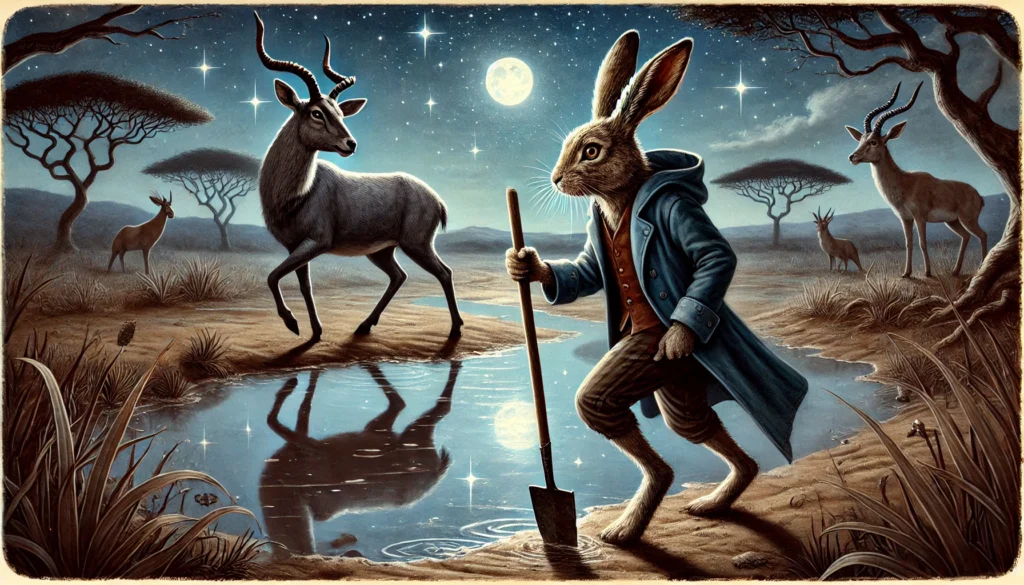
“You will get thin and die of hunger, if you stay like that at the edge of the pools. Listen! You would do much better to come with me and till a field. Then, in time of famine, you would have something to eat.”
“Let us go!” said Antelope.
Hare set to work in grand style. He gave Antelope a hoe and told her to dig. “I can’t get on my hind legs,” said she, “and hold the hoe with my forelegs.”
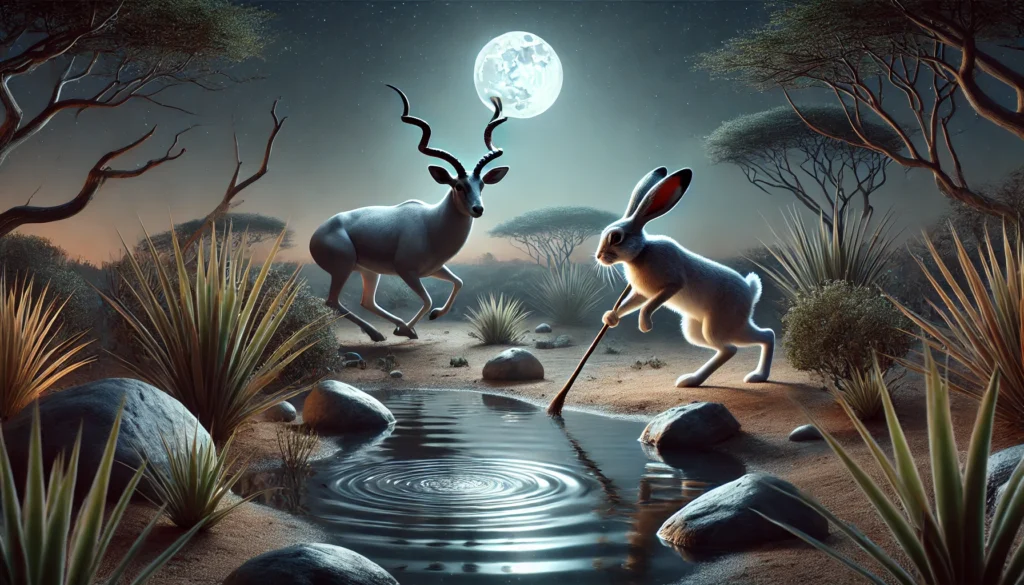
“Let me have a look at your forelegs. I’ll tie the hoe to them, and you will be able to did all right.”
Antelope tried, but she couldn’t do it.
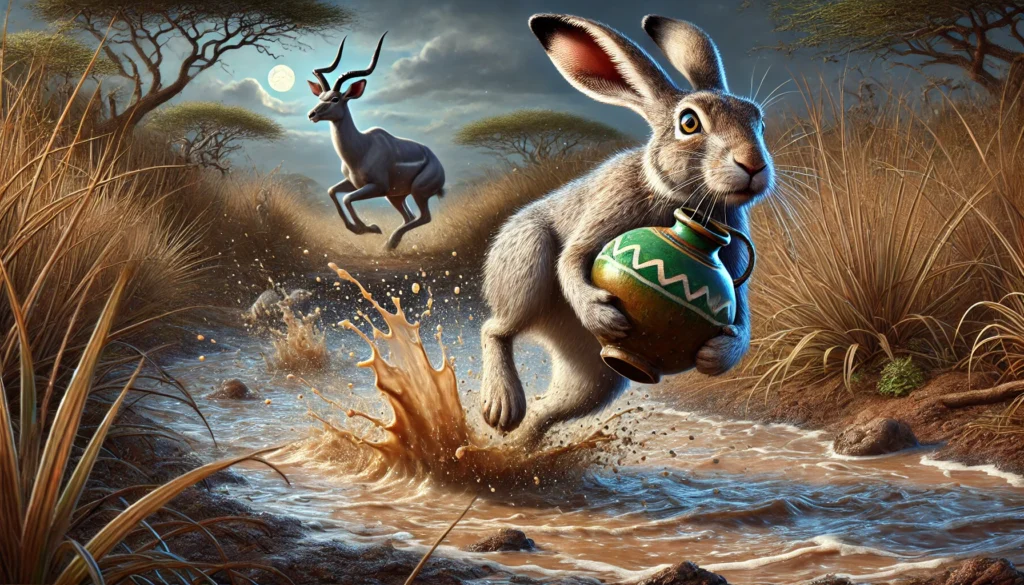
“Never mind,” said Hare. “Wait a minute.” He ran back to the pool, quenched his thirst, and muddied the water. Then he filled a calabash and hid it in the bush. On returning to Antelope, he said, “Hello! Haven’t you done any hoeing yet?”
“No, I can’t manage it.”
“Would you believe it! An Army has passed by, and they have stirred up the pool.”
“No!” Truly? Untie me, Hare!”
“I won’t untie you unless you swear that what I said is true.”
“Very well! Untie me.”
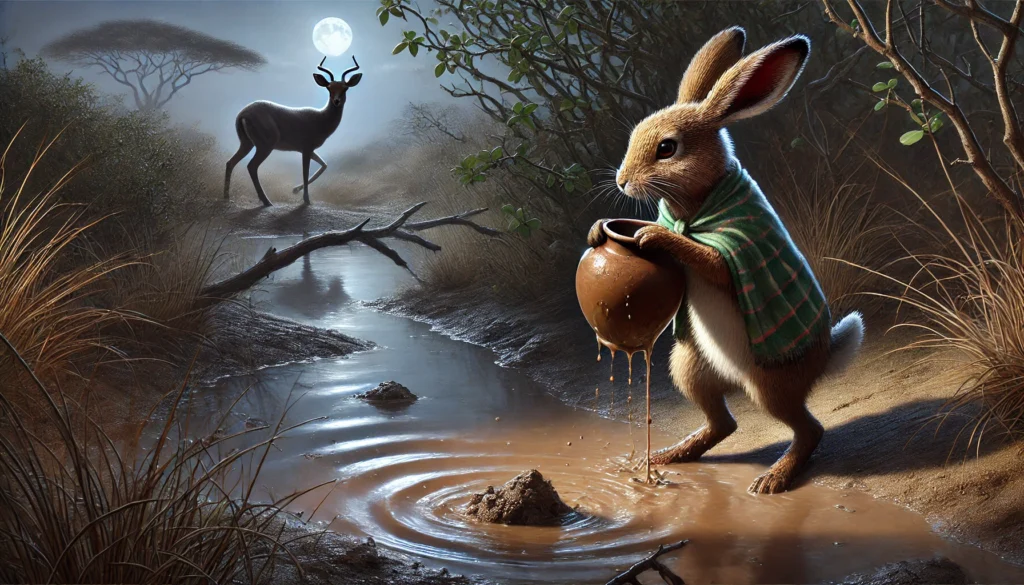
Off Hare went to get the calabash to give her a drink, and made her promise to confess that it was she who had disturbed the water. Then he called the chiefs, who killed Antelope.
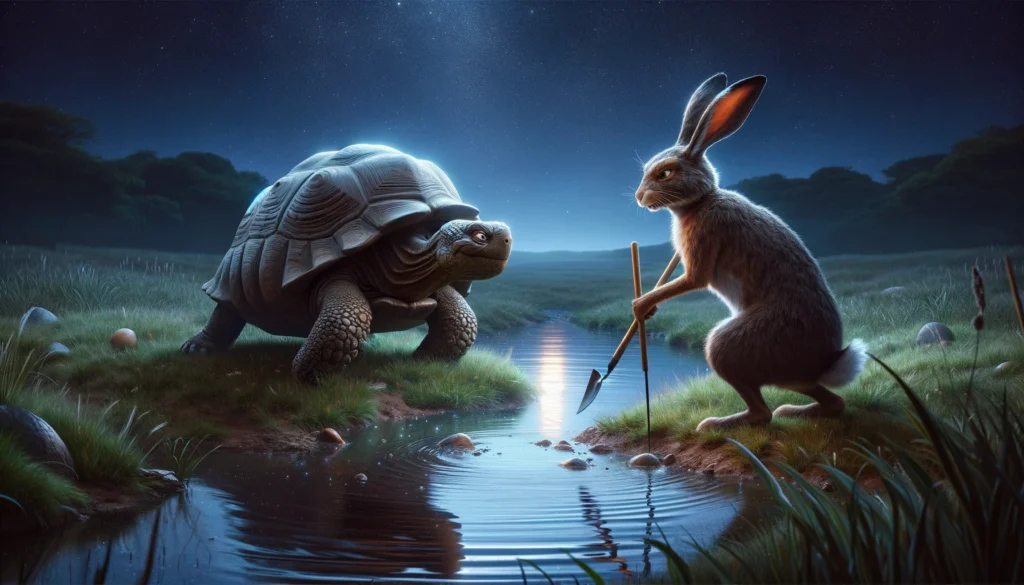
But there was one creature that outdid Hare in cunning and that was Tortoise. She mounted guard at the pond. Hare arrived there. “You will die of hunger, if you stay at the edge of the pool with nothing to do. We had much better go and till a field together.”
“How can I hoe with short legs?” asked Tortoise.
“Oh! That will be all right. I’ll show you how to do it.”
“Eh! No. thank you! I think not!”
“Well then! Let’s go and help ourselves to some of the wild boar’s sweet potatoes.”
“No,” said Tortoise uncompromisingly, “No pilfering!”
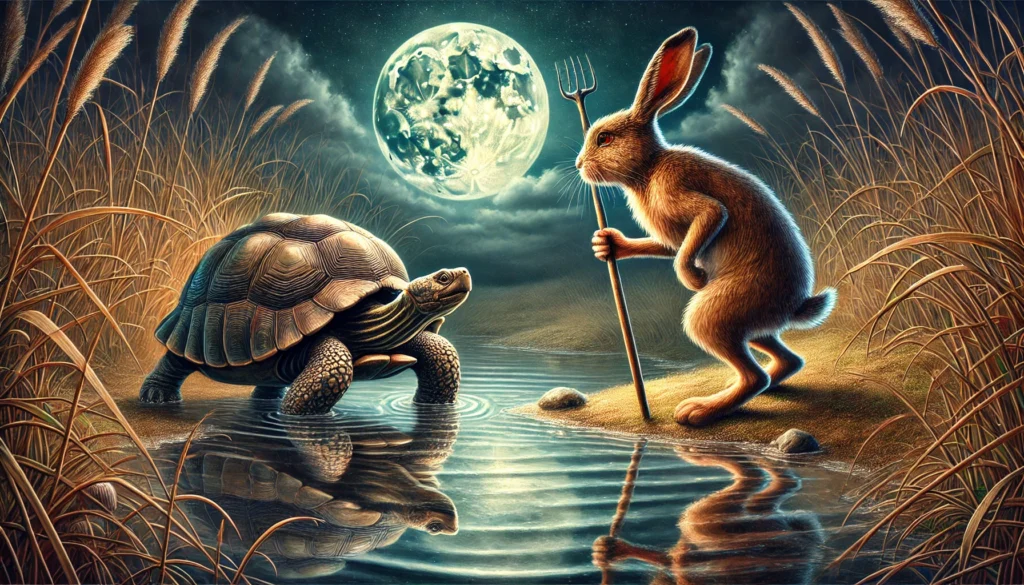
However, before very long Tortoise began to feel hungry, so much so that, when Hare again proposed a marauding expedition, she overcame her scruples and they went off together to root up the sweet potatoes. Then they lighted a fire of grass in the bush and roasted them.
“Tortoise,” said Hare, “just go and see if the owners of these fields are anywhere about, as we must not let then catch us.”
“Yes, but let us both go. You go one way and I’ll go the other.”
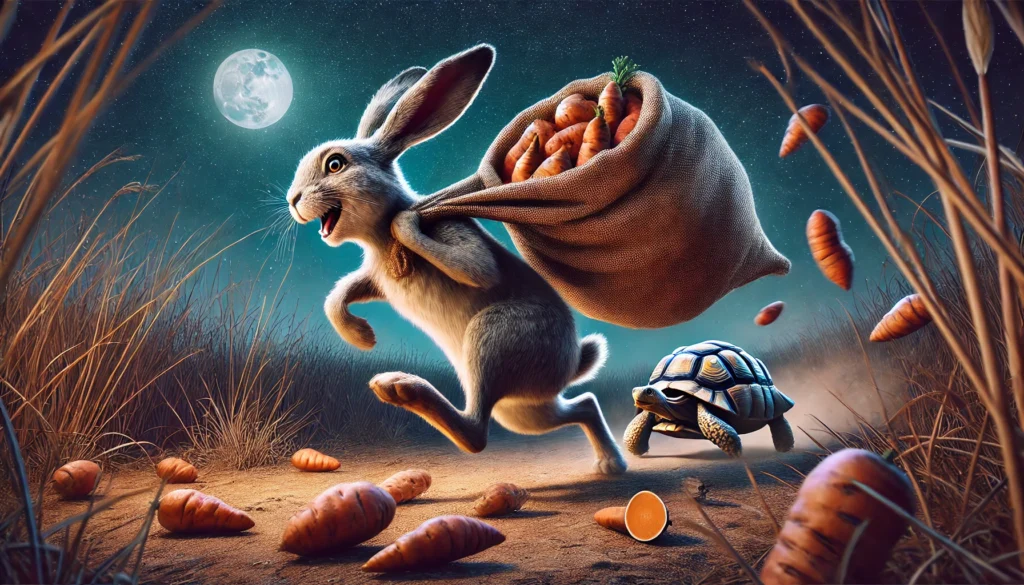
Off went Hare, but Tortoise, instead of following his example, stayed behind and crawled into Hare’s sack. Hare soon came back, filled up his bag with sweet potatoes, threw it over his back, and ran away to escape the proprietors, shouting at the top of his voice, “Hi, Tortoise! Look out! They will catch you! I’m off! Fly”
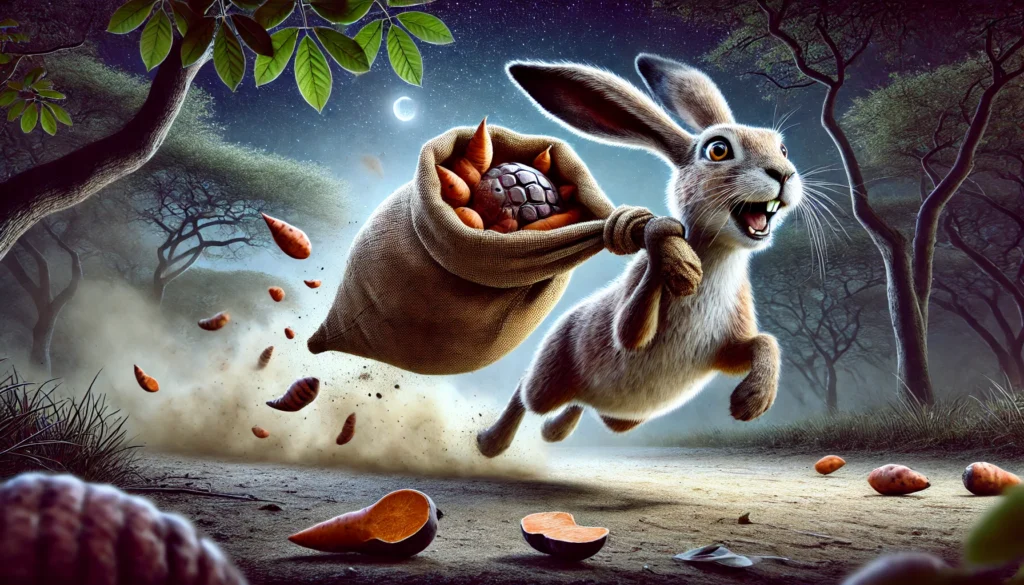
He ran as hard as he could to escape capture. Tortoise, inside the sack, ate the sweet potatoes. She picked out all the best ones and finished the lot. She said, being satisfied, “Kutlu.” After a while Hare was tired out and lay down quite exhausted. He felt the oangs of hunger.
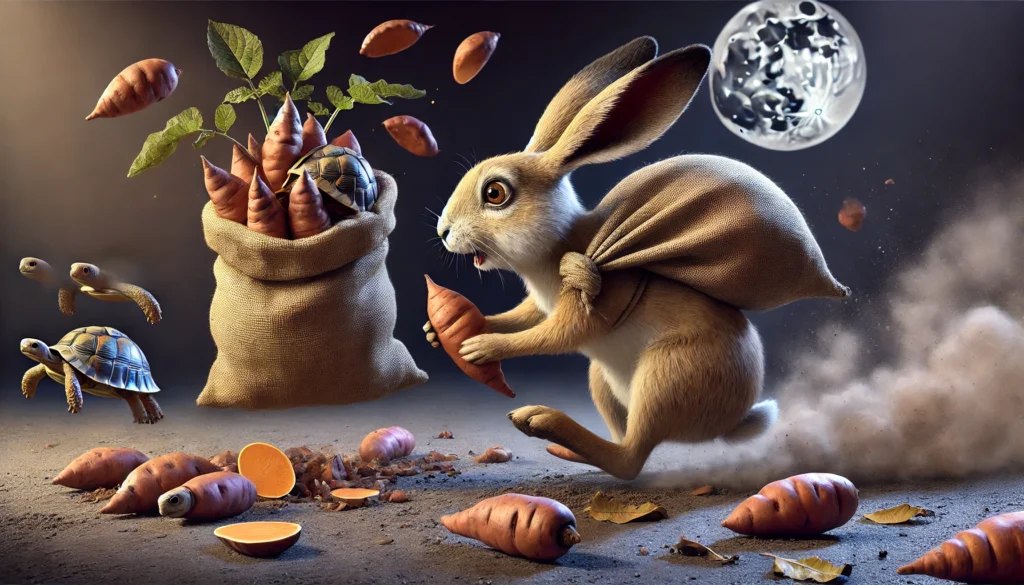
“Aha! Said he to himself. “I will have a good feed!” He sat down in a shady spot, opened his sack, out his hand inside, and pulled out one very small sweet potato. “This is much too small for me,” said he, and putting his hand in again, felt a nice big one. “Oho! here’s a beauty! When he had pulled it out of his bag, what was his surprise to find that his potato turned out to be Mistress Tortoise!
“Hello! Why! It’s you!” he cried in disgust and threw her on the ground. She scuttled away as fast as she could. Then Hare began to wail, “When I think that I have been carrying her all this time!” He felt very crestfallen.
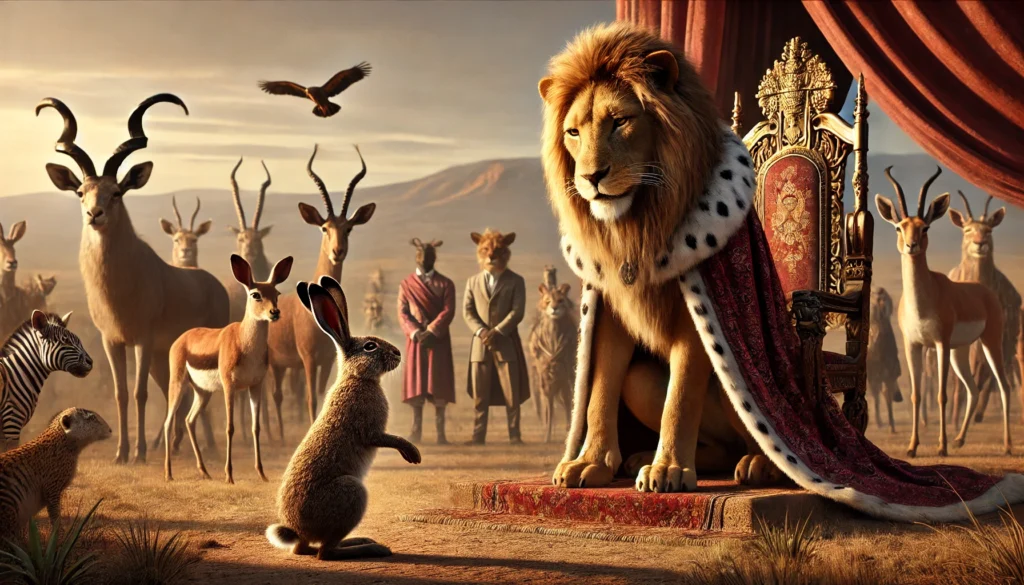
Continuing his travels. Hare next met King Lion, surrounded by his courtiers. He at once asked permission to swear allegiance to the king and to settle in that country. But every day he went out to steal other folk’s groundnuts. When the owners of the fields came to look at their crops, they exclaimed, “Who can it be that digs up our groundnuts?”
Hare went off to find King Lion, and said to him, “Sire, your subjects are not what they should be, for they are in the habit of stealing.”
“Indeed!” said Lion. “Go and keep watch, and if you discover anyone stealing, catch him.”
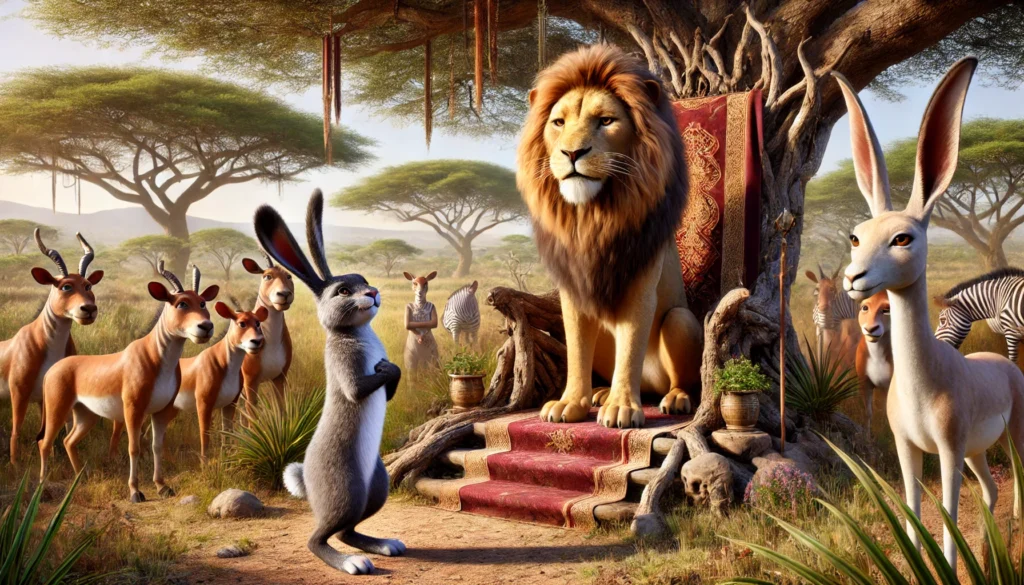
Hare went off to take up his position in the fields, but Lion followed him and surprised him in the very act of feasting on groundnuts. “Ha! Ha! You tell me that my subjects are not honest folk, while it is you who do the thieving!”
“Not at all! I was only keeping a look out! Come here, and I will show you the footprints of your subjects, for I know them well!”

So they went to a large shady banyan tree. Hare made a strong string of one of the long tendrils and said to Lion, “As you think I don’t speak the truth, just sit down here and you will soon see the thieves passing by. I shall while away the time by making you a crown of wax.”
“All right,” said Lion, “make me a crown.”
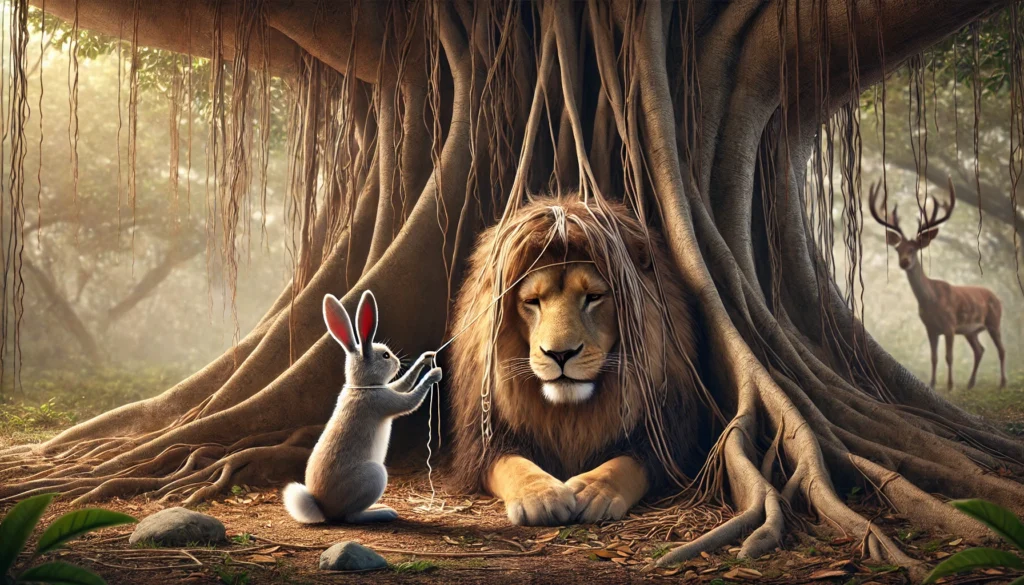
Hare began by parting Lion’s mane down the middle and arranging the hairs carefully, one by one, on either side of his neck, as if he were preparing a spot on the top of his head for a crown. Then he made holes through the bark of the tree, on both sides of the trunk, and passed the hairs of the mane right through them, some on one side, some on the other. This done, he tied all the hairs securely together at the back of the tree with the string he had made, and he said to Lion, “I’ve finished the job. Jump up quickly and you will see one of your subjects stealing in the fields!’

Lion tried to jump up. He couldn’t! He had half killed himself struggling to get to his feet!
Hare ran to the village. “Come,” he shouted, “And see who it is who ravages your fields! He had previously torn up a lot of groundnut leaves and thrown them down close to the Lion. The villagers hurried to the spot.
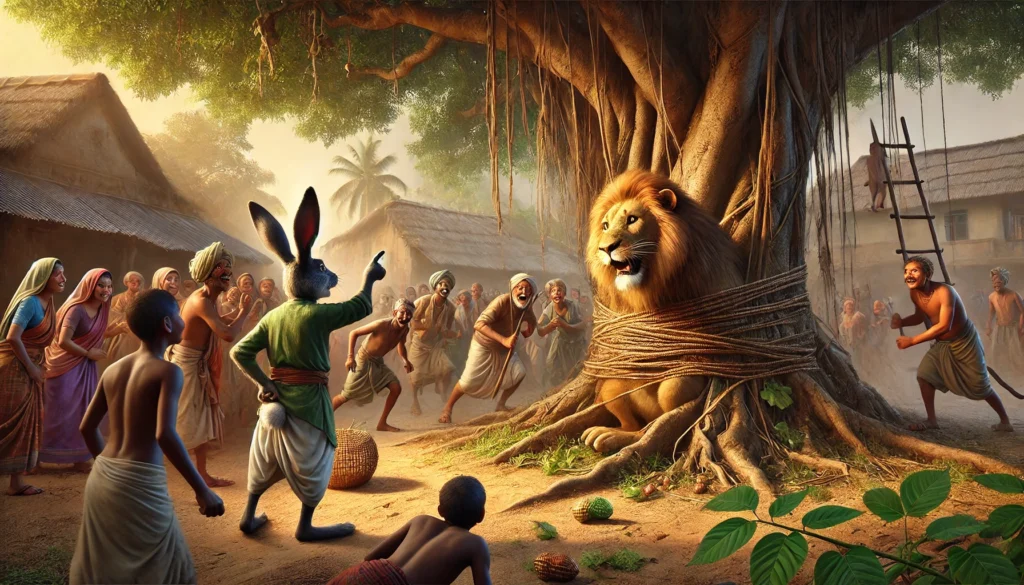
“There! Don’t you see him?” Haven’t I found him out, eh?” Lion didn’t dare to say a single word.
Then his subjects cut great staves and beat him to death. “Ah! Hare, You are very clever, and we are grateful!” they said.
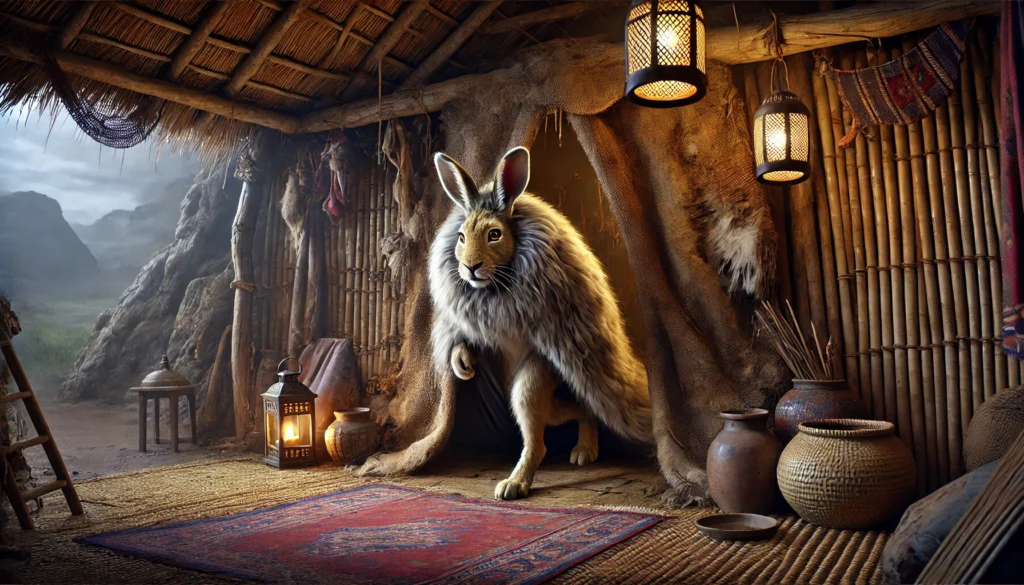
Hare cut Lion up into pieces. Then he took the skin and wrapped himself in it. Thus disguised, he went to Lion’s village and entered the queen’s hut. He said, “I am not well,” and shut himself up, refusing to see anyone. he gave orders to servants to kill an ox because he was ill. Then he had a second one slaughtered, then a third.
The women said to him, “Are you going to move to another place, since you are killing all your oxen?”
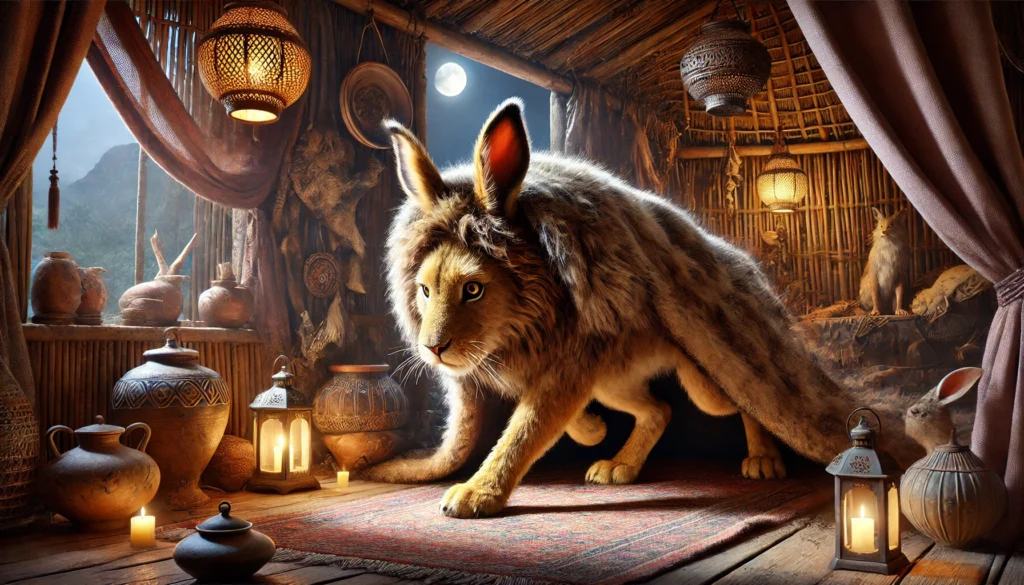
“No,” said Hare, “I have no intention of moving any more. I am killing them because I know very well that I shall never get over this illness.” So he had a general slaughtering of all Lion’s oxen, goats, and sheep, to the very last head of cattle. When all were killed, he said to the queen, “Haven’t you got my money in your keeping?”
“Yes,” she replied.
“Well, bring it all out and put it together with my royal mat and all my valuables on the village square.”
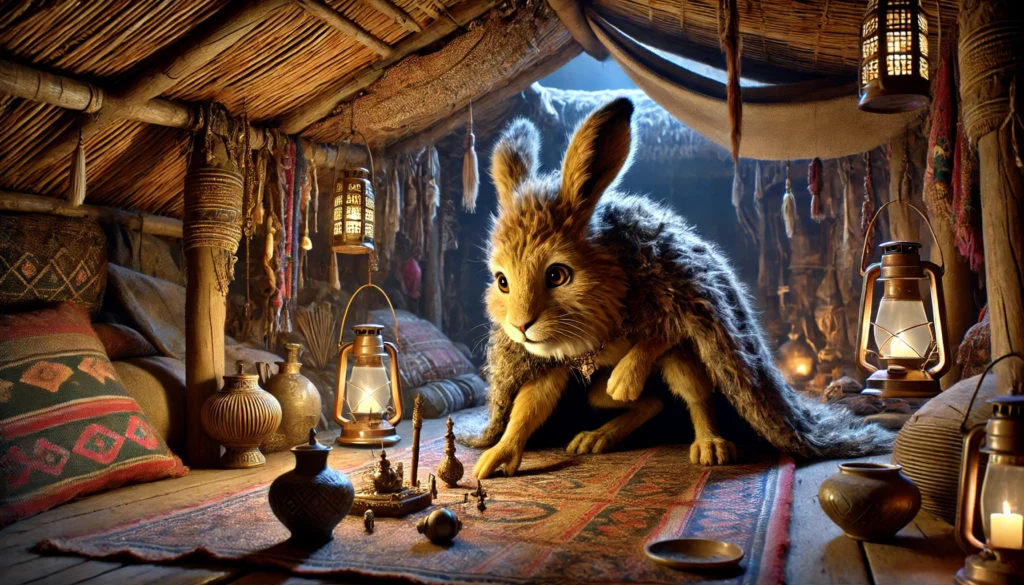
The lion’s skin had now acquired a rather loathsome odor, the flies were settling upon it in swams, and Hare was by no means comfortable inside of it.
“What sort of complaint have you got?” asked the queen. “It is something that smells very nasty.”
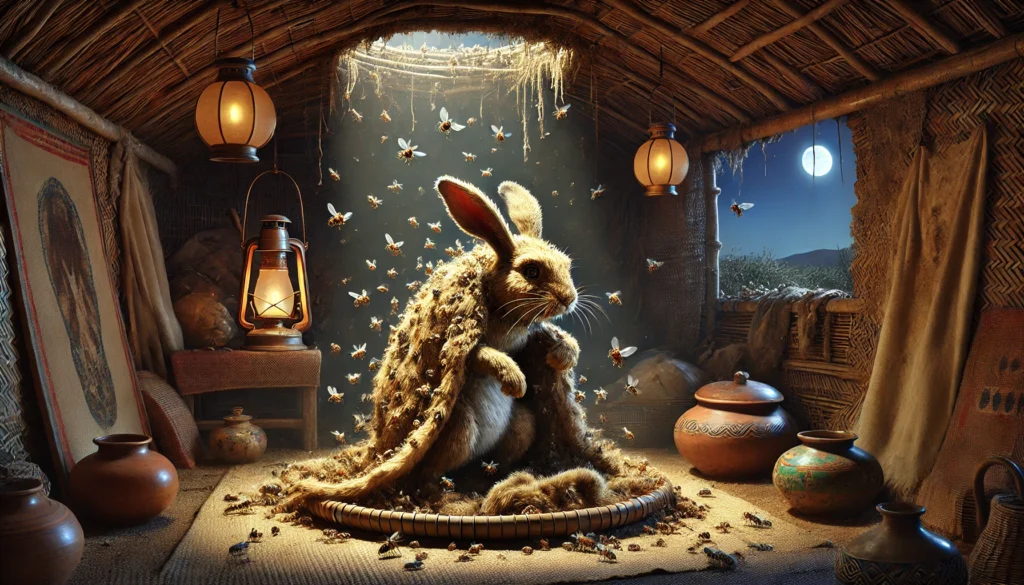
“Oh! I have only got some sores. I must go and find a doctor. Good-by, I shall start at once.”
Lion’s wife replied, “Then I will go with you, my husband.”
“No,” said he, “No occasion for that, for I know exactly where I must go.”
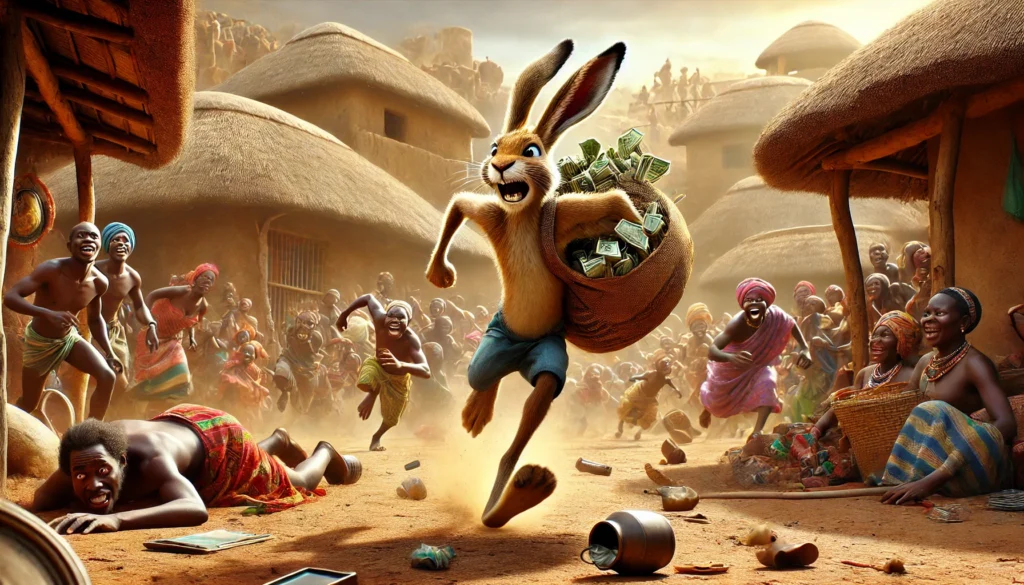
He went out to the square, picked up the mat in which all the money and valuables had been packed, and then, throwing off the lion’s skin, he tore away as fast as his legs could carry him with all the village in pursuit.
Hare came to a burrow, and in he ran. The pursuers got a hooked stick to pull him out. They tried to hook him and managed to get hold of his leg. “Oh, pull away!” cried he. “Pull away! You’ve only got hold of the root of a tree!”
So they left off pulling. They tried again, and this time they really hooked a root.
“Hi! hi!” he yelled. “Hi! hi! Take care! You’re hurting me! You’re killing me! Ow! Ow!”
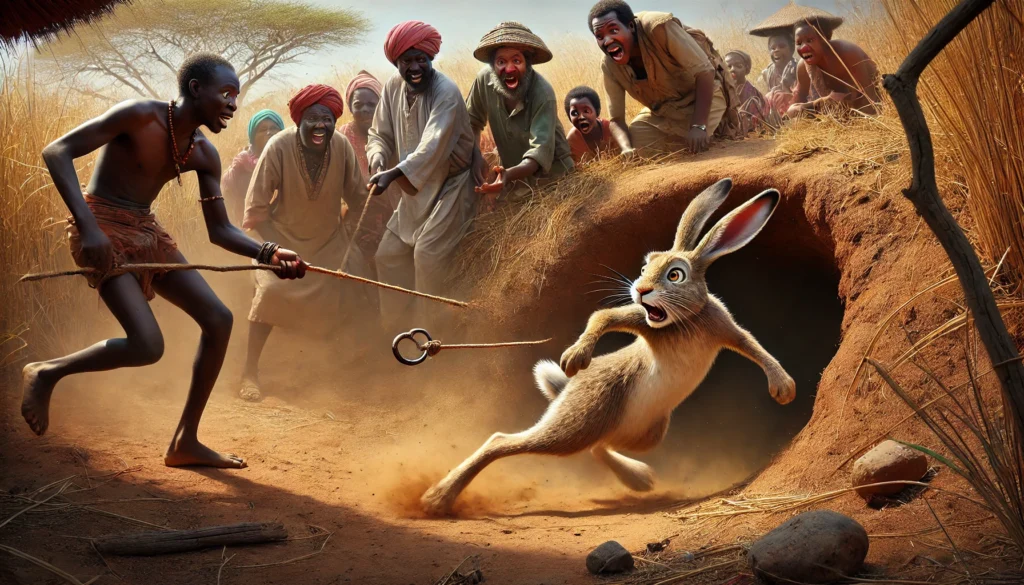
They pulled as hard as they could, and they pulled and pulled until the hook broke and they fell over backward. They said, “Qaa.” Finally they were tired out and said, “Oh! Let us give it up and leave him where he is!” So they stopped up the burrow with a bunch of grass and went away.
The south wind no sprang up and blew the grass deeper into the burrow.
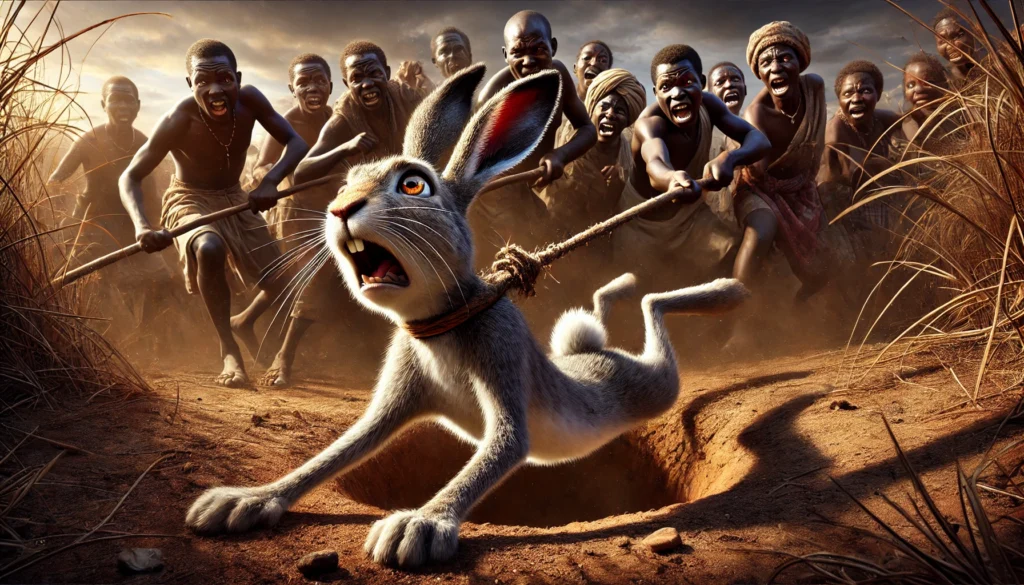
“I am done for,” said Hare to himself, as he fancied they were succeeding in getting nearer to him. He was suffering the pangs of hunger and was terribly thirsty, but not dare to leave the burrow, supposing his enemies to be close at hand. At length he cried out, “Have pity on me and let me go, my good fathers, I beseech you!” He crept cautiously toward the entrance of the burrow, and found only a bunch of grass. Then he made off at once, leaving all his treasures behind him, not even giving them a single thought.
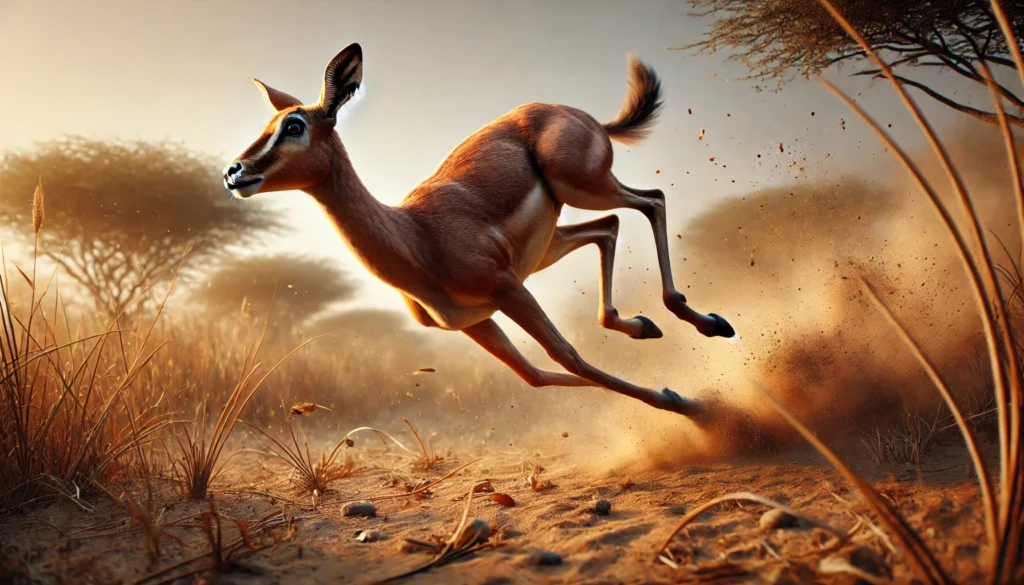
He ran on and on. He became thin and ill. He ate grass, but it did not remain in his insides; it passed through him immediately. He came to the home of Grey Antelope. “Say, Antelope, suppose we sew one another up! You stitch me up, but not completely, you know! It will keep the grass much longer in our insides when we browse, and we shall get much more nourishment out of it.” Antelope consented, and partially stitched up Hare. Hare sewed her up entirely. Antelope swelled and died. Fortunately for her, however, she fell in a field belonging to a woman who picked her up, put her in her basket on the top of her head, and carried her to the village to be eaten. She gave her to her husband to cut up. He set to work and began by cutting the stitches that Hare had sewn. All that was in Antelope’s interior at once came out, she jumped to her legs, and galloped away.
She met Hare, and she said to him, “All right! I’ve found you out now! Never again do I call you my friend!”
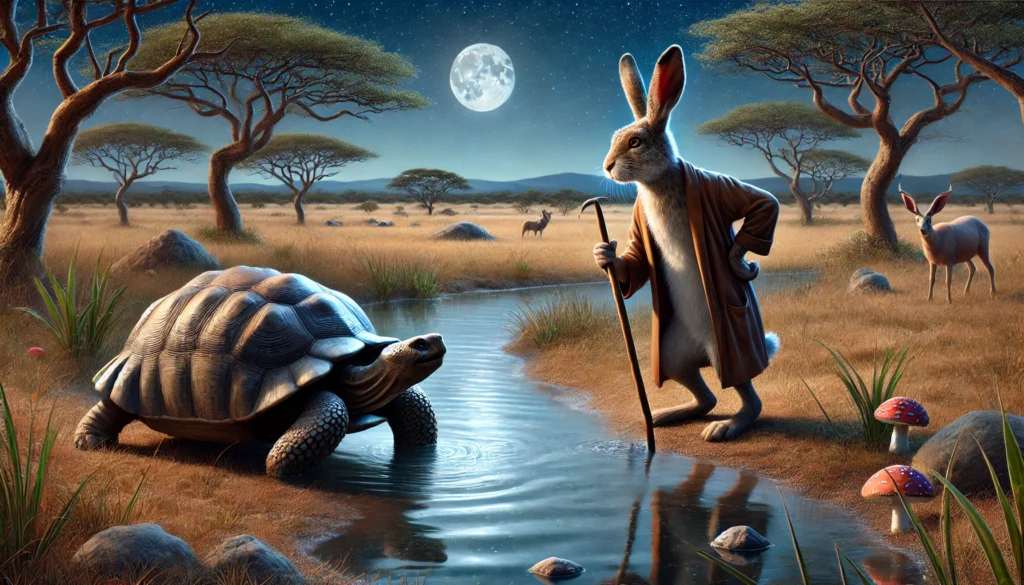
Hare, being thirsty, was looking for a pool but could not find one. At last he came to one where no one was on guard. Tortoise was really in charge, but she was in the water. Hare walked in. “What luck! How nice and cool it is!” said he, quenching his thirst and swimming about. Tortoise snapped at one of his legs, then at another.
“Hello! Let me go! I’ll promise you a goat if you will let go!”
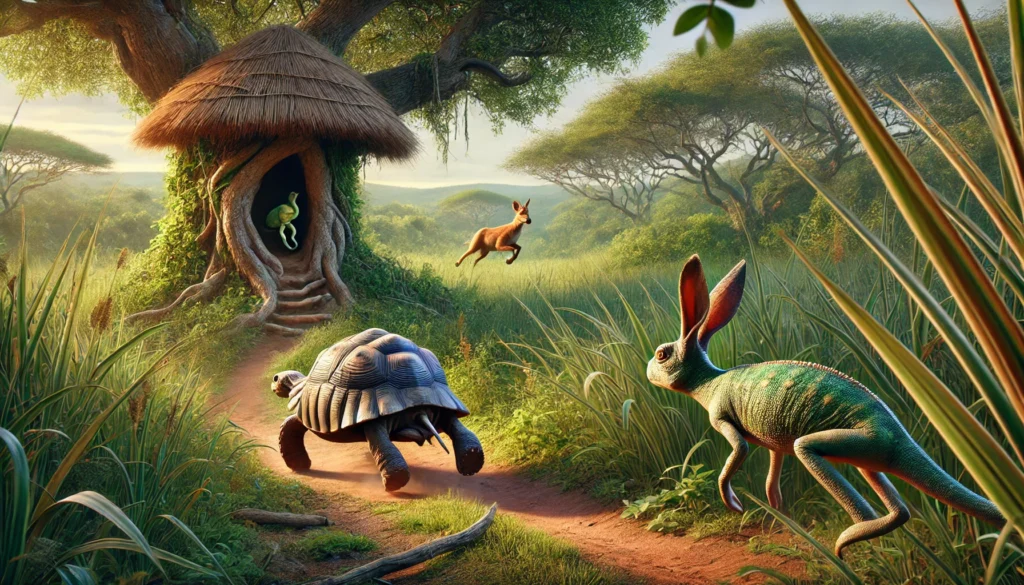
They came out of the pond together, and Hare said to her, “Come along to my house, and get your goat.” They reached his home, but no goat! Nothing! Hare did not give her anything. Then he remembered the money that he had left in the burrow and said, “Let us go and see chameleon. He has my valuables, for he borrowed a lot of money from me. I’ll just run round and fetch my brother; he knows all about the business and will be my witness.” Having said this, Hare ran off. Tortoise arrived at Chameleon’s abode and said, “Give me Hare’s money which he says you have!”

“What! I haven’t anything belonging to Hare!” Whereupon Chameleon blew into Tortoise’s eyes. She swelled, and died.
That’s the end.
[THONGA }
